Part Two - The Diesels & Electrics
1968
On January 16th 1968 my last steam locomotive worked was 48294, relieved men at the top of the shed and worked down to the docks, then light engine to Northwich via Bidston and Dee Marsh.
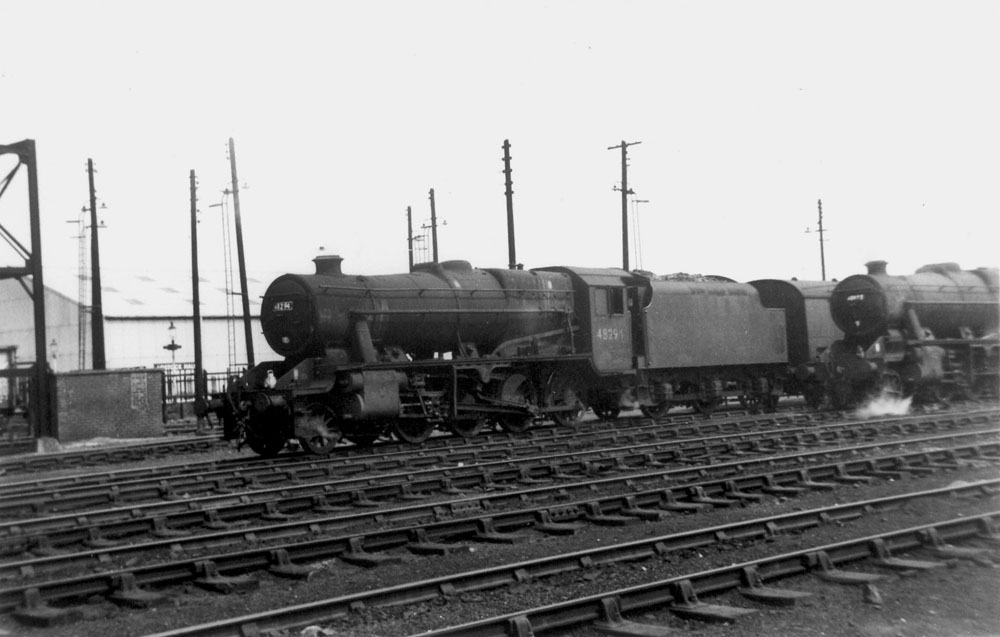
Near the end of January on Monday 27th I was on the Mersey ballast job with M Roberts and locomotive D2388, booking on at 20.50 and signing off at 06.10.
March 2nd produced an unusual job, initially booking on at 06.25, with the instruction to pilot a tamping machine from Bidston Dock to Bank Hall sidings. Back then drivers of tamping and other track machines did not sign a route card, also the foreman had told me to go straight home once we reach Bank Hall, a good job for me. On arrival at Bidston Dock I meet up with the tamper driver, and off we go via Dee Marsh, Mickle Trafford, Helsby, onto the WCML at Acton Grange as far as Wigan then down through Wigan Wallgate station and off towards Liverpool, branching off at Fazakerley past Aintree, down to Marsh Lane Junction, then along the Southport line towards Bank Hall sidings. It was a very cold trip, the early tamping machines left you very exposed to the elements. We shunt onto an empty road in the sidings at Bank Hall, and stop close to the buffer stop. Here's the crunch, the tamper driver says to me we always put a red flag and detonators down, just in case they put something else into this road, standard procedure. OK I said, five minutes later he's still looking for detonators. We have none, I give him a look, don't have to say anything, he knew, then I walked away thinking to myself, what if etc etc. I often thought who would be to blame if some mishap had occurred, my own judgement would be the tamper driver was responsible.
A new freight bonus scheme started on March 18th, it was a good thing good for us but had the potential to compromise safety. It kind of worked with the faster you were doing a job, quick turn around in yards, more trips done. On our day Northwich turn we were getting fourteen pounds a day doing two trips, we were only booked for one. On one similar turn later that year (July 31st in fact) with 5292 we were doing two trips Docks - Northwich - Ellesmere Port - Northwich - Docks. My mate was driving on the second trip moving fast towards Hartford and Greenbank Junction, the distant signal was on and we had brakes on only six fitted wagons. There was no chance of stopping, eventually we passed the home signal at danger coming to a stop by the signal box. The signalman was at the window looking down, he said he had noticed the freight trains going faster, he told my mate to slow down, then let us proceed. Eventually the bonus scheme was abandoned. I think it had come too late, when you were working mixed freight trains, you knew the passenger train timetables by heart, so you could adjust your freight train working to fit in with the passenger trains. The bonus scheme started at about the time that block train workings were taking off. Also thrown into the mix during the early seventies was the introduction of the EQ brake on certain locomotives. This modified brake allowed the driver to select brake settings depending on the type of train you were working. On freight timings the brake would go on gradually to minimise the discomfort to the guard in the brake van. The downside to this was it took longer to reach a full brake application. Everybody got one day's training on EQ brakes, however some drivers would defeat the object of the brake system by putting the brake timings over to passenger, which would create a quicker brake application. At Birkenhead examples of Classes 24, 25 & 40 were fitted with EQ brake equipment.
During April three days were spent training on the 350hp Class 08 shunters at Ellesmere Port West End, with one of the four shunt drivers at Ellesmere Port.
Late in May 1968 Jimmy was my regular mate for a while, on 28th we book on at 21.15 with Type 4 D1847 and are given the Leeds oil tanks to work via Arpley, Skelton and Edgerley, I think we had a mixed train of 45 & 100 ton tanks. Weeks earlier we had worked the same train over three nights with a conductor from Edgerley so I had signed the road as far as Healey Mills. We arrive at Stockport just after midnight, no relief is waiting so we were going to shut the engine down and make our way home. Jimmy says to me you signed the road, go tell control you will conduct me, which I do and they say go ahead. Off we go, approaching Denton Junction I'm expecting the right hand peg in order to go under at Guide Bridge and join the main line further on. Instead we get the left hand one of the three pegs, I say to Jimmy I don't know where that one goes, the middle one would have taken us through Guide bridge station then left at Ashton Junction up to Stalybridge, but I knew one of the bridges on that route had 100 tonner restrictions. I tell Jimmy I'm stopping at the box to ask him which way he is sending us. Jimmy says keep going we'll be all right, now whether he knew more than he was saying I will never know. I slowed down for the curves at the junction thinking if this goes wrong its on my head, then onward under the bridge and we come to Ashton Moss North Junction, right hand peg of two, approach Crowthorne Junction under the overhead wires, through the trailing crossover, down to Ashton South Junction, right hand peg of two, past the goods yard where the electrics terminated and out onto the main line at O A & G B Junction.
Was I glad to see the main line again! now it eastwards to Stalybridge and the climb up to Diggle with the loaded hundred ton tanks came 20mph restrictions over certain bridges all over the system etc. It was then an easy trip down to Healey Mills where we stop for relief. A driver walks across to our train, shouts up I have to conduct you, not trained on the Hawker Siddleys he says. I said to Jimmy they call the Brush Sulzers Hawkers? He said the speedo is made by them. Anyhow the driver gets on board, I pull forward whilst Jimmy heads off to the back cab, now we're en route to Leeds with the only one officially trained on the locomotive in the back cab! Mind you Jimmy knew more than the instructors about diesels, but he did not shout about it. When we were approaching Wakefield Kirkgate, I said to the conductor you can take over now, he said I couldn't, you know I'm not trained, I said neither am I. He was older than me, I said I'm passed to drive on steam and diesel shunts, have to wait until all the drivers at shed are trained.
He was made up, so we're now moving along to Leeds getting daylight, he said what time are you on, I said we're on overtime now, adding that when Birkenhead men are given a job which may involve overtime they always finish it within reason, so Control know we can be relied upon. I got on well with the conductor, at the time I did not know where about in Leeds the oil train was going to terminate, some went to Hunslet. We go beyond Hunslet and end up at Neville Hill, we spot the tanks, when changing ends Jimmy asks where are we? I say Neville Hill, Ok he says, what's next? I go to the yard office, on my way there the foreman tells me that Control want to know if we'll take the empty tanks back. Wait a minute I say, I nip back and tell Jimmy, he says I'm driving today so its my decision. OK I say, we'll take the empties back. The conductor's quite happy with the decision, so we back up on to the tanks, and have a break. Just getting ready to depart when the foreman shouts a change of plan, Control want you to go back via Sowerby Bridge, now I can't remember whether the conductor was on the road that way, but Jimmy was.
As an ex-Lankey man Jimmy knew most of the road, the conductor was keen to go and we would need him as far as Milner Royd Junction. Everybody's happy as we move off with a nice steady run back, I took over at Sowerby Bridge, must have been around 10am at that point, the conductor said put me off in Victoria, I'm on overtime now, dropped him off in the station and away we went. Jimmy came through as we were crossing Chat Moss and said he enjoyed the trip, I said we're on mileage now, down to Stanlow detached the tanks and then light engine to Birkenhead, finally booking off at 13.30. Can't remember which guards worked the job with us, maybe we had Les! Not too sure whether the electrics were still working from yard at Ashton, I can remember the overhead equipment still in place.
With regard to the above trip Mal remembers there were at least three routes that could be used when leaving Stanlow, obviously the one in the story above used the route through Helsby and Frodsham before turning on to the former LNWR lines at Arpley, east to Lymm, onto the former CLC Lines at Skelton Junction, back on to the LNW after Northenden, through Stockport and right at Heaton Norris towards Denton and through the complex of lines in the Guide Bridge area before connecting with the former LNW route through Standedge tunnel. One could also use the less travelled route via Helsby, Mouldsworth & Northwich to Skelton Junction. Eventually both these route were no longer useable due to line closures so the oil trains ran via Earlstown across Chat Moss to Manchester.
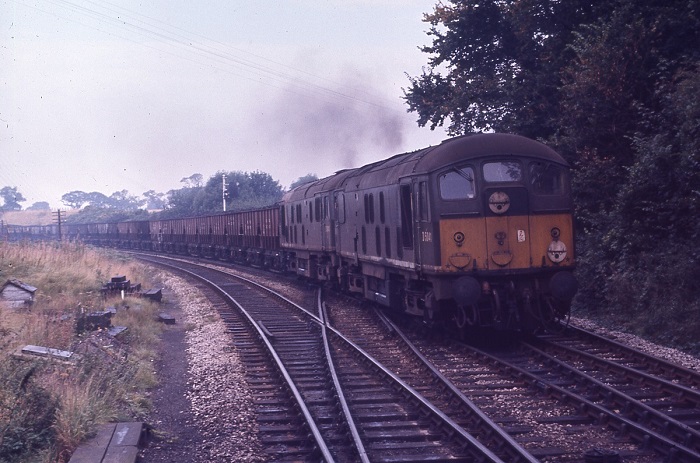
On August 20th 1968 booking on was at 21.15 then light diesels to Ellesmere Port using Type 2's 7627 & 7554 working to Healey Mills via Rochdale, then home passenger booking off at 10.15. I finally trained on Type 2's during July 1969. My first job in charge was light diesel to Stanlow, then to Crewe with D1544. At Crewe South shed 5002 was collected to work a train to Ellesmere Port, then light engine to Birkenhead. This job was single manned.
With so many drivers to be trained on the diesels they booked a class 47 for a special daily job. It was light engine to Grange Lane carriage sidings opposite the shed where eight coaches were attached, then right away Shrewsbury, run round here and take a short break, then back to Birkenhead. I got the job quite afew times in winter seeing as I had trained on steam generators, as had happened in my time at Bletchley.
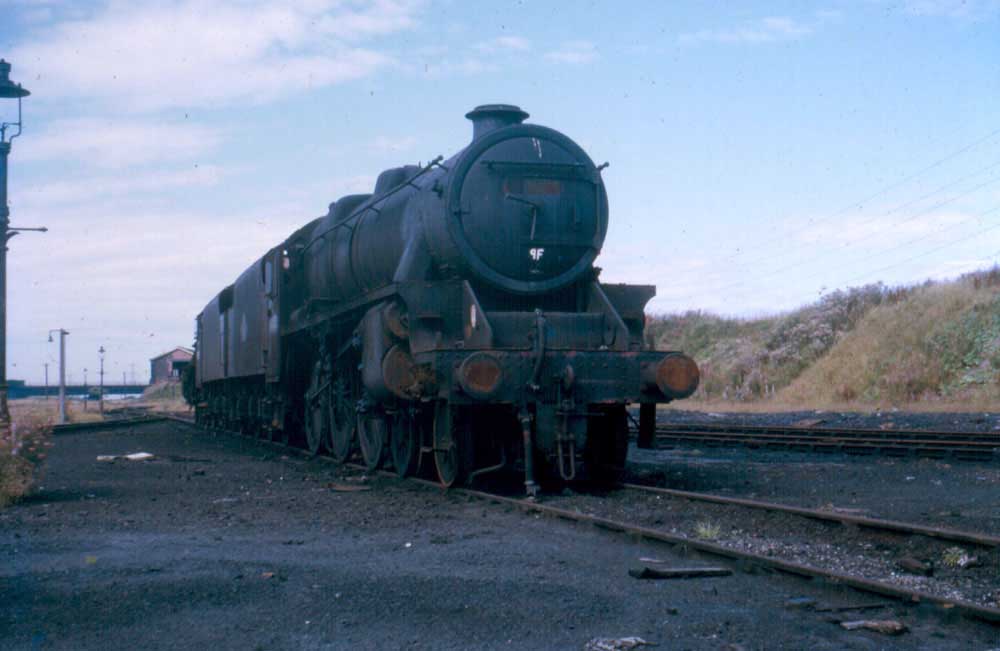
It was a strange week's work starting the Bank Holiday weekend of September 2nd 1968, the week's jobs were all with driver J Waterson, signing on each day at 19.35 and travelling passenger to Newton Heath:
September 3rd, we get to Newton Heath and find the job has been caped so its home passenger, signing off at 07.20.
September 4th, at Newton Heath we go light engine D1632 to Moston Sidings to work a mixed freight to Birkenhead Docks, signing off at 07.30.
September 5th, at Newton Heath we collect D1757 to run light diesel to Birkenhead - see more to this day's story below.
September 6th, at Newton Heath we take D5289 light engine to Moston Sidings and work a mixed freight to Birkenhead Docks, signing off at 09.15
To expand the story on September 5th we were approaching Manchester Victoria when we were stopped outside, I got down to the signal phone and the signalman instructed us to pick up a set of Carlisle men on the station platform and take them to Warrington, where they could get a service home. We pick them up, they travel in the back cab, I went through en-route to have a chat with them. We had just passed Vulcan Foundry, my mate had shut off power for the 50mph restriction at Winwick Junction when the engine died, we were now coasting over the junction.
We clear the junction, I'm on my way back to check the overspeed trip when I bump into a Carlisle man who tells me he'd already checked it on the way through and it's OK. Both Carlisle men were about the same age, so I did not know who was driver. Anyhow we're still coasting and come to a stand short of Winwick Quay box, now stopped on the WCML up fast line. I tell my mate the Carlisle man checked the overspeed and says its OK, he starts scratching his head. I walk forward to the box and inform the signalman of our predicament. I wait in the box until the signalman tells me to return to the locomotive and inform my driver we're going to get assistance from the rear in about twenty minutes.
He stops a parcels train outside the box, a class 50 with Crewe men, they give me a lift back to our stranded locomotive, I'm just stepping on when D1757 bursts back into life, I step down again and inform the signalman who now tells us to proceed. As I was stepping back onto the locomotive my mate was by the door, he put a finger to his lips to keep quiet, I was wondering what was going on. We dropped the Carlisle men off at Warrington Bank Quay, after we cleared the station, I said what's going on to my mate. He said when you were gone I searched and checked all the routine things that could stop the engine, including rechecking the overspeed trip, it had tripped, once reset it was all OK. I asked what did the Carlisle man say, he said sorry and went to back cab. Johnny was a good engineman. We sign off at 03.30am.
We had a new job from Stanlow Ground Frame, sign on at 02.55 then light diesel to Stanlow to work to Whittington Oil sidings then light diesel to Croes Newydd shed then home passenger on a Wrexham - Birkenhead North service. There was also a once a week working to Marchwiel, down the single line from Wrexham Central. One day we had a named Western Region Class 47 1669 'Python', my regular mate went crazy, polishing the controls, the ATC worked on the journey, he was very happy! He was an ex-GWR man, crazy about anything which involved the GWR. As 1669 was allocated to the Western Region and fitted with dual AWS & ATC, which worked over the route from Chester, my mate would be looking in the repair book seeing which Western depots the locomotive had visited. The line from Wrexham Central was awkward to traverse with our train coming from Saltney Junction. We would have to shunt the train across from the main line into the sidings, then run forward onto the Cheshire lines side, forward under the main line and into Wrexham Central station. This line used to go as far as Ellesmere, we used a small section to go down to Marchwiel. We also picked up a railman with keys to open the gates across some roads, and into the fuel complex. After spotting the tanks we would go light engine to Croes Newydd shed, and leave the locomotive.
As on the Whittigton job the Wrexham brewery was close to the shed, and the railway club so we would sample some Wrexham Larger, good brew. Then go home passenger on the Wrexham - Bidston line. At Birkenhead we never worked up the branch to to Brymbo or Minera, I would think only Croes Newydd men signed that route.
I had to wait a year to be trained on the diesels, on Classes 08, 24, 25, 40 and DMU's followed a year later on the Class 502 EMU's. I had previously trained on the Drewry diesel shunters that were used at the docks.
One class of diesel locomotive that Birkenhead men were not normally trained on were the Class 37's, which come into play in this next story. Around 1968/1969 we had a diagram to work back from Stockport Edgeley, to either Ellesmere Port or Birkenhead Docks, not sure of which now. The diagrammed locomotive was a Class 47 being brought in by Healey Mills men. After a while North Eastern Control started putting a Class 37 on this job, knowing that Birkenhead men were not trained on this traction, so the Birkenhead driver would have to conduct the Healey Mills crew all the way to Birkenhead. The Class 37 would have to go back light engine to Healey Mills, so we would lose a locomotive. One of our driver's, Austin was fed up with this arrangement, so he relieved the train with the Class 37 on at Edgeley. When the locomotive was left at the fueling point on shed nobody would move it, they had to get the traction inspector to deal with it. When Austin was asked why he relieved the Healey Mills men on a type that he was not trained on, he said with it being dark could not tell difference, he was given a reprimand. Not sure of the exact date but my diary shows that Les Johnson and myself took Class 37 No. 6889 light engine to Patricroft on February 2nd 1968. The diary doesn't record if we had a conductor, I know Les was not trained on the traction. My opinion looking back now, if the driver felt confident about taking the locomotive so be it, not hydraulic engines but diesel electric.
Every Sunday at Birkenhead we had a cattle train to York, we booked on around 18.00, then light engine down to the docks and attach the cattle wagons. These wagons were piped but had no brake gear, making them blow throughs. Thus trains comprised entirely of these wagons were loose coupled. The train also carried a drover who travelled with the guard in brake van. These workings were booked to stop at certain points, to allow the drover to walk down the train, tapping any cows with a stick to make them stand up, in the sitting position they were in danger of being trampled.
Initially Birkenhead men did not sign the road beyond Patricroft, thus requiring a pilot as far as Manchester Victoria. As the men from other depots transferred into Birkenhead so the routes signed for became more varied. In addition to the York working there was also another train that involved the movement of cattle. For this we booked on around 18.00, took a Class 24 down to Western yard and attached a mixed goods train. Then it was off to Chester where wagons were picked up and others removed. It was here that frequently four or five cattle wagons would be added, which had come from Holyhead. We would take the goods train onto Crewe, here it would be remarshalled, but for us it was time to catch the last passenger train to home to Liverpool. Somehow we always managed to miss this working so as to get our overtime.
One night I asked my driver should we get on to Control and maybe get another job, he said we're guaranteed eleven hours now. But rather than just coming home passenger, I wanted a little more activity. So he said ring Control if you want, tell them we'll go anywhere. After placing the call Control asked if we knew the road to Carlisle? I said yes and my mate's ears pricked up! Control advised there was a Morris Cowley car train approaching Crewe with a WR Warship class locomotive, this would be detached and we were to get a Class 40 off the depot and work forward. I said we will as long as we don't get relieved en route. He said OK and we left Crewe with seven hours on duty. We reached Carlisle at six in the morning, backed the train into Kingmoor yard, returned the locomotive to Carlisle depot, returned home passenger and finally booked off around 13.00. The foreman said to our guard Roger, how can you work a train from Crewe to Carlisle, when the only part of the road you signed is from Acton Grange to Preston! Here's your route card get the road signed. My mate at that time was Don Buckley, ex Edge Hill, one of the best mates I ever had. He told a good story, he used to tell me a poem about D9, which in the early years was based at 8A, maybe somebody might remember it?
We also had a split diagram with the Leeds tanks which involved working a tank train to Healey Mills, then home passenger. We had booked on at 13.40, my driver was Les Johnson was ldc man and ec member, on this trip we reached Stockport Edgeley where two sets of Yorkshire men walked up to locomotive and asked if our train was the Leeds tanks. We said yes, they said it should be two steam locomotives, they were not trained on diesels and we had Class 40 D311. Les asked if I wanted to go forward with this job, I said we're rest day time and three quarters, at about the same time a set of Stockport men walked up to the locomotive and said we're relieving you. Les said no your not, your conducting us, the men walked away angry.
Les said he was going over to see the foreman, so lock the cab door and don't let anyone on the locomotive! From the secondman's seat this all appeared very interesting, ten minutes later Les returned. I asked if we are we getting off? Les said no, a Stockport man will conduct us to Healey Mills, the conductor got on board, not much was said and off we went. After about ten minutes the conversation began, he explained that Healey Mills had no work late on Saturday so we would go through to Leeds. We ended up by Neville hill where we put the train away and returned light engine to Holbeck shed for our break. We were quite friendly now with the Stockport man, Holbeck shed was full of Class 45's.
The foreman advised that after our break we were to take the locomotive back to Birkenhead. We went to the Tetley pub just outside the depot. I can remember the signalman's voice when I rang off shed, as I announced light diesel to Birkenhead, he sounded shocked. He told us we would have to go via Sowerby Bridge, that was Les Johnson's route, he had been an ex-Bank Hall driver and had worked trains to Leeds Central and Bradford from Liverpool Exchange. The Stockport man got off at Manchester Victoria, we ended up going via Chester, it was now Sunday morning now, with track work all over the place. We eventually signed off at 04.00!
Speaking of night jobs I eventually worked along side a driver called Jimmy. He had been the driver on the 02.10am Birkenhead Docks - Grange iron ore train which had lost control on the approach to Chester. At the time the secondman was at the controls and is believed to have nodded off. The runaway was diverted off the mainline into the depot tracks, which at this early hour were not too active. A number of Class 24's standing at the depot were hit, sustaining damage which resulted in the retirement of several of them. Jimmy was a quiet man, our link was mostly at night so he got me interested in astronomy. Our first job together was from Warrington Arpley to Birkenhead Docks, it was a long mixed goods train with a Warrington guard in the brake van. We had a Class 40 which required a bit of handling when working loose or partly fitted trains. When you opened the controller there was no notch, as on other diesels. So the locomotive would surge forward, we got going and Jimmy was snatching the train. You could feel it, but I couldn't say anything. When we arrived at the docks we detached the locomotive and then stopped to pick up the guard as we passed his van. He stood there with blood coming from a cut on his head, he said to Jimmy 'you gave me a rough ride!' Jimmy said he had a lot more to learn about these diesels. From then on he let me do much of the night driving on the diesels.
After signing on at 12.15 on November 7th 1968 it was light diesel to Stanlow with D Williams and work a tank train to Stoke Cliff Vale, spot the tanks then light diesel back to Birkenhead, signing of at 20.39. Our locomotive this day was Class 47 No.1111, the last of the class.
The Stanlow shunt trips job were double manned, the job required an air brake fitted shunter, D4157 was used regularly. I had the job for a week Monday to Friday commencing December 2nd 1968, signing on at 15.46 and signing off at 23.35. This job including tripping around Ellesmere Port and Stanlow, you got a good meal on this job from the Shell food delivery van!
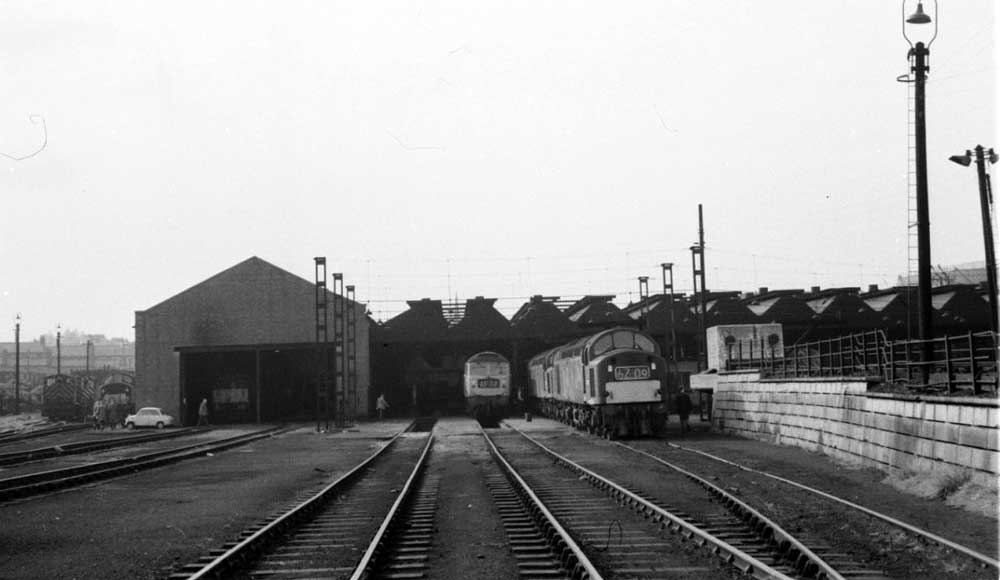
![]()
1969
Very early on in 1969 I changed links, my new driver was Eric Kelbrick, an ex-Brunswick man, a very conscientious driver, his father had been a driver at Brunswick which was a former Great Central shed, he used to tell me about the Liverpool Central to Manchester Central services with the 40 minutes express running between the two cities.
Our first job together was on January 13th signing on at 07.28 then light diesel from Birkenhead to Stanlow GF, work a tank train to Crewe with 1843. At Crewe we were relieved, took a break and then worked back to Stanlow with 1854, then light engine back to Birkenhead, signing of at 20.30. The routine for the following four days was a little different, signing on was at 10.00, signing off at 18.00, except January 14th which was 19.05:
January 14th - passenger to Chester Diesel Depot, take 5008 light engine to Crewe, then work a train back to Ellesmere Port, then light engine back to Birkenhead.
January 15th - passenger to Chester Diesel Depot, take 5063 light engine to Crewe, then work a train to Mold Junction, then light engine back to Birkenhead.
January 16th - passenger to Crewe Diesel Depot, collect 5043 and work a train to Mold Junction, then light diesel to Chester and home passenger.
January 17th - 5137 light engine to Chester station, then work a parcels train to Crewe, return light diesel to Chester Diesel Depot and home passenger.
The following week, still with Driver E Kelbrick, brought a few more familiar workings and a couple of unusual ones. On January 22nd sign on was at 12.25 then passenger to Northwich to relieve a train bound for Shotwick, the locomotive was 223 Lancastria, then light engine to Birkenhead and sign off at 00.05.
January 23rd - sign on 12.05 with 1939 light engine to Stanlow GF, then work a tank train to Stoke, detach on shed and home passenger, signing off at 20.25.
January 24th - similar to January 23rd except that after arriving at Northwich the train was late so we returned home passenger, signing off at 21.10.
January 25th - sign on 12.15 taking 222 Laconia light diesel to Hooton to work a car train to Shap Summit, here we changed footplates with Carlisle men and worked a train south to Crewe with 1815, after leaving the locomotive at Crewe Diesel Depot it was home passenger, not sure of the sign off time.
January 28th - sign on at 15.35 then passenger to Stoke, light engine 1852 to Trentham and work a train to Birkenhead Docks, signing off at 02.40.
Other shunt jobs handled included a working on Saturday February 13th to take D3104 & D4157 to Chester with a Crewe driver, signing on at 07.45 and off at 18.15.
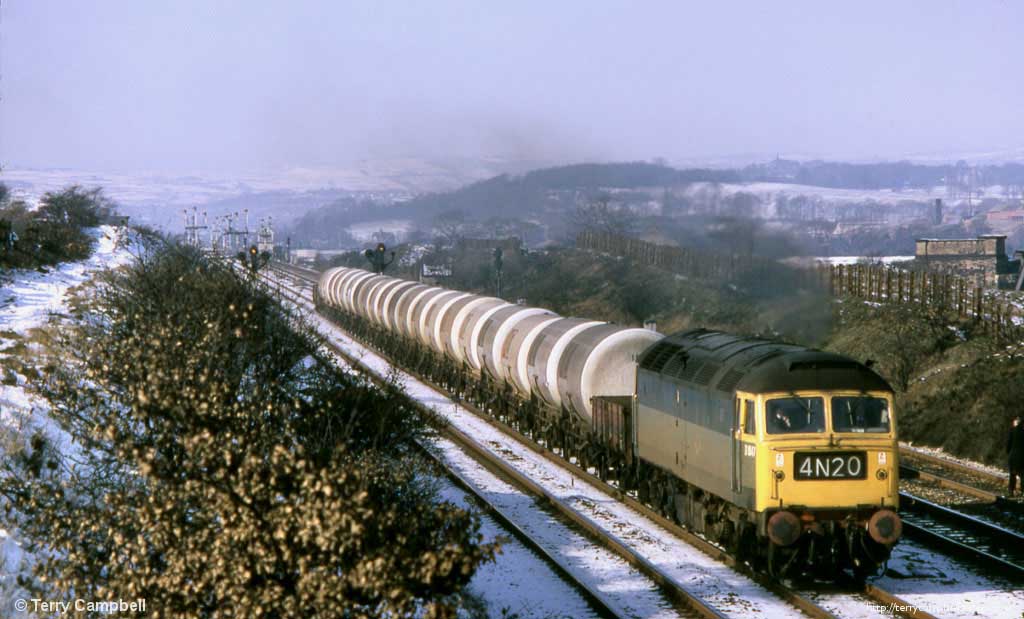
When Mal was at Birkenhead the top link became the DMU jobs, which upset the older drivers, no more overtime! As soon as the railcars arrived the links were restructured, at a union branch meeting some younger drivers proposed the top link should be diesel railcars Passenger, so it was carried on a vote. The older drivers were unhappy. Everything was based on seniority. Other links were the No.1, No.2, No.3 & No.4 goods links, the regular running jobs at the top, then the control link - in this link after you booked on you would go passenger to Chester and sit in the mess room at the end of platform 13, and work to Control's instructions. I missed this link when arriving, some work on this link included specials to Rhyl and beyond along the coast. Then there were the extra links which covered any work. And last of all the shunts. On transfer to Edge Hill they had extended No.1 link here to hold 36 men to share the mileage. Before that time this link was a contract mileage link, that is work London out, lodge then work back, then a trip to Leeds, out and back to London again and finish, link set like that. When I arrived the No.2 link was DMU work, a big link, the extra link had 48 men in it, followed by all the goods links, trippers and shunts.
One strange thing early on was some drivers started working for securicor Part time, what was funny they would bring the wages to the shed, including their own. Also some drivers and secondmen started going plate laying on a Sunday, at the same rate as platelayers, they would work every Sunday. I could be on a ballast seeing our drivers digging with shovels, very funny. I never done this. Then at another branch meeting, some of the drivers who did not do this practice, put a motion in that if a driver goes platelaying the Sunday should count against him, as a driving Sunday, it was passed, All our Sundays were special work, so they were shared, except two DMU Jobs, the afternoon Braintree, and the shedman's jobs. It meant the ones who did not go platelaying got more Sundays I don't know whether this happened at other depots.
March 12th was an interesting day, it began by booking on at 11.45 with no assigned job. The TCI asked driver H Jones and myself to work a special, a train of steel coils from Dee Marsh bound for the Scottish Region, Hugie was working the train as far as Lostock Junction, he asked would I conduct him on to Blackburn, all agreed and off we go. Our locomotive was 1841 which ran light engine to Dee Marsh, here our train was a lengthy string of bogie bolsters loaded with the steel coils. The brake van at rear has a Birkenhead guard going as far as Blackburn. Not sure of the exact time but when we arrived at Blackburn it was almost dark, a driver walked up to the locomotive and said he was conducting us to Hellifield. The signals cleared and off we go. We're plodding along and further on we get stopped at Clitheroe, the signalman tells us the guard has taken his lamps in, waving whilst passing the last box. I tell the signalman I'll walk back and ascertain what's going on. When I reach van the Birkenhead guard asks me where we are going? I ask where's your conductor, he says he has not got one. I inform the signalman, my driver and Control, its agreed I would ride with the guard and we would go forward to Hellifield, we were told we would not be stopped again. Another adventure, eventually signed off at 02.40, can't remember how we got home from Hellifield!
On Friday March 28th the job was the nightime Mersey ballast at Birkenhead Central with 3088, signing on at 21.15 and off at 09.20. The Mersey ballast was a link job, ran almost regular, I know Class 47's were allowed down tunnels under the river, for I have worked with one, however the Class 40's were not allowed. Later battery units were used on this job, I did go out on one job with these and remember the rows of batteries inside the unit. Some fatalities occurred with these units at Hamilton Square because of their quietness.
The week commencing April 21st brought quite a variety of jobs. It began with booking on at 16.39 only to find our booked job had been caped. So we were given the Elswick tanks with driver E Warburton, one of four brothers who were all drivers at Birkenhead, the tanks were bitumen tar and were always conditional trains (run when required). Our locomotive was 1740, going light diesel to Ellesmere Port east end, here I rang control and asked if I could conduct my driver from Manchester to Healey Mills, this was agreed so off we went through to Healey Mills, getting relieved and returning home passenger, booking off at 07.30.
The next day, April 22nd, we booked on at 19.30 after twelve hours rest. With driver A Williamson we were given a special to work with locomotive 216, running light engine to Green Lane. Here we attached a train and worked via Dee Marsh to Cheadle, detach here and light engine to Godley, attach and work train to Garston, detach here and run light engine to Garston holding sidings, then home passenger, booking off at 09.20.
April 23rd was booking on at 21.20, taking up another job with A Williamson, a special to Milnthorpe, Alan had signed Carlisle so we would be going through to Milnthorpe, at the time we're wondering what's at Milnthorpe? We leave Ellesmere Port east end with locomotive 345 and another train of bitumen headed for Oxenholme. Here we run around the train and put the tanks inside at Milnthorpe and detach, realising now they were putting the road surface down on the nearby M6 motorway. Then its light engine to Preston where we are relieved and return home passenger, booking off at 09.40.
The next day brought a relatively straightforward working, booking on at 21.40, given a job with driver N Griffiths and locomotive 1856, light engine to Stanlow GF, work to Preston where we were relieved, home passenger and booking off at 09.35.
On April 25th booking on was at 21.35 with driver G Drew and we were given a job to Healey Mills. I would be conducting my driver from Manchester Victoria with locomotive 5091. After being relieved at Healey Mills we were asked to take forward a train from Haverton Hill, some kind of ammonia in 100 ton tanks for the Shellstar plant at Ince and Elton, Shellstar, our locomotive was 1582, which we took back Birkenhead after dropping the train off at Ince, booking off at 10.25. This weeks work was my late afternoon turn which happened quite often, this was unique, could only happen at very few depots.
At the beginning of May it was my time for formal training on subjects such as main line diesel locomotives, air brakes and loose coupled trains. The course would run for about three months, it had taken more than two years to get everybody through the training course. The course started on May 5th at 06.50, travelling to Wigan Springs Branch for the classroom tuition with RSI. Second week and following time was at Birkenhead with Don Buckley, who was my instructor and would be my regular mate at a later date. Later on during the course you would go out on the main line.
Over the three months we trained on English Electric 2,000HP, Brush Sulzer 2,750HP and the Baby Sulzers 1,160HP & 1,250HP. I passed with the footplate inspector after each locomotive. My average pay per week for this period was sixty eight and a half hours, average taken from the three months before training began. This was like a long holiday for me, in bed every night, good pay, I must say I did get fed up before the training had finished and was glad to get back to my normal routine. With the training completed and the holidays over it was back on the job during August. Now we have driver only turns on unstarred jobs, and double manned on starred jobs, you were able to go on unstarred jobs, but could be taken off for other work if needed. Starred jobs were diagrams over eight hours, or if a meal break could not be fitted in for the driver, specials were double manned and a driver working overtime would be double manned, it was very complex at the beginning.
My next regular driver was Vic Radford, an ex Aintree man, we had some good laughs together. Our first turn together started by booking on at 09.30 on September 22nd, going light engine with 1955 to Stanlow GF, to work a tank train to Preston, being relieved here and then home passenger, booking off at 18.25. The next day, the 23rd it was booking on at 07.28, then light engine to Stanlow GF, to work a tank train to Salop, Crewe Bank, detach here then light engine to Croes Newydd shed and home passenger booking off at 18.20.
On September 29th we booked on at 11.35, going light engine with 1964 to Ellesmere Port, to work a train to Shrewsbury, being relieved here and working back with 1627 and a loose coupled train as far as Bamfurlong Junction. We had said we'd work as far as Blackburn, but it took so long we could not go any further, booking off was at 06.20. After the required rest period the 30th we started at 18.20 but we were sent home at 22.30 to catch our time for the next day. So for October 1st we signed on at 11.25, going passenger to Newton Heath, here we relieved a train with 394 for Warrington extension sidings, detach here and run light engine to Birkenhead and sign off at 20.10.
Monday & Tuesday September 15th/16th I was sent on loan to Liverpool Sandhills on a ballast working with two Liverpool Exchange drivers, both who I knew, the locomotive was D2867.
![]()
1970
On January 21st 1970 we're signed on duty just before midnight at 23.57. A new name appeared on the engine arrangements board - Iron Bridge, I am marked to the job with driver Jimmy Barrat, a nice easy going guy. I meet his son at a much later date. Our locomotive is 5137, the job is running as a special, at the time we did not know where this place was. We set off light diesel for Ellesmere Port West end and attach to a small train of tanks. Possibly this was a test train, or maybe the power station had not long opened?
Off we go up to Hooton, run around the train then its off to Chester, taking the line that avoids the station, past No.6 signalbox and on to Saltney Junction, here we know the road as far as Shrewsbury, we climb up Gresford bank, on through Wrexham and Ruabon, as mentioned earlier this ex-GWR road was very smooth, on to Gobowen, Coton Hill and down into Shrewsbury station getting ready to be relieved. The station is very quiet this time of the morning, we come to a stop by a driver and guard on the platform. The driver steps on board and says he has been told to conduct us forward. With all on board we take the Wolverhampton road, on through Wellington and stop at Madeley Junction and run round the train. We get the token from the signalbox, then down the single line to Lightmoor, here the double track starts so we hand over the token, from here its down grade to the power station.
Its daylight now so we get to enjoy a little of this scenic route. We spot the tanks and are instructed to take the locomotive light engine to Shrewsbury. Having dropped off the locomotive we travel home passenger after an enjoyable trip out. This Iron Bridge job was to become a booked turn later, with single manning coming into fruition the diagram became Birkenhead men to prepare the locomotives then to Stanlow, work to Chester where they are relieved and return home passenger. The Chester men work the round trip to Iron Bridge. A Birkenhead crew go passenger to Chester to bring the train home. Three drivers and three guards to do diagram, very short jobs.
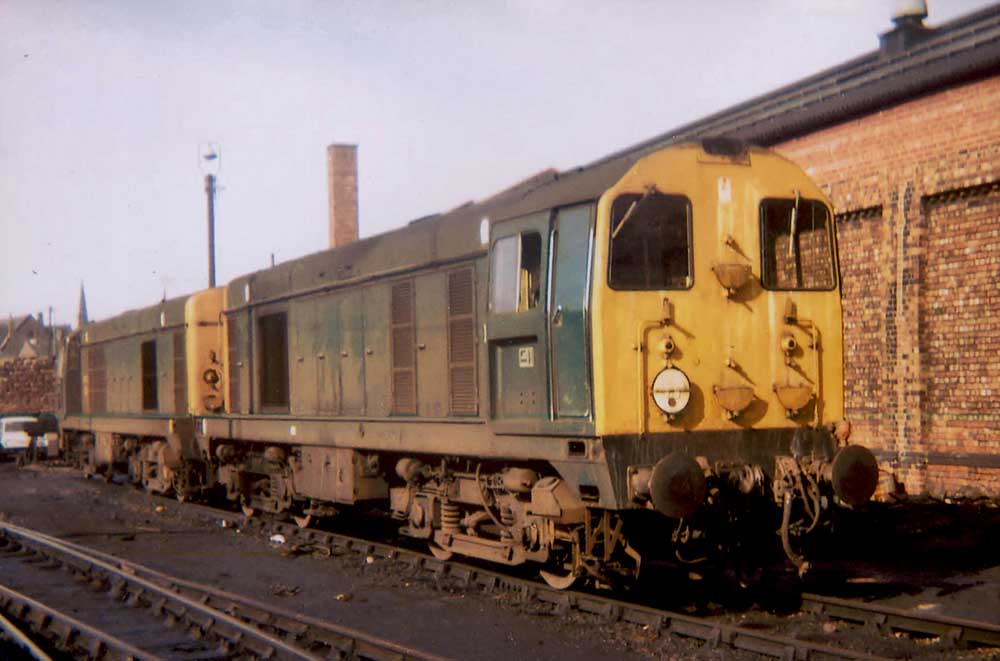
Occasionally Toton Class 20's would show up at Birkenhead, they would most likely have worked the Bestwood Park - Ellesmere Port West End with coal slack for Bowaters. Their use on these workings was a bit of a sore point - this was one of our diagrams, working out to Stoke-on-Trent, take a break and then relieve the incoming train, which was diagrammed for a Class 47. When the train turned up with Class 20's in the hands of Nottingham or Toton men, the Birkenhead driver would conduct them over the road to Ellesmere Port, then they would return light locomotives. If the Nottingham men were on very long hours, they might advise Control that after arriving at Ellesmere Port they were going home passenger. So the locomotives would end up at Birkenhead. I hated sitting in the back cab, I liked driving, my mate at that time let me do all the driving on nights. Mind you saying all that I loved going to go places which were not scheduled so I can't blame the Nottingham men!
A number of names come to mind with regard to my regular mates at this time: Jimmy Murphy, Johnny Kay, Jack/Les Johnson, and of course Don Buckley. It was during June that I changed links and joined up with Don, an ex Edge Hill man. On the jobs with Don I used to take plenty of sandwiches to work, just in case we were on long hours, which occurred quite frequently! Its June 20th and my first week on with Don, we're booked on at 00.04, our locomotives are 5049 & 5082. First its light engines to the Docks to pick up an iron ore train for Stoke on Trent via Chester and Crewe, loose coupled, we detach train at Stoke and have our break. Control had asked us to work back to Chester, Don asked where the train was going, they said Wrexham, Don said we would take it all the way. So we attach to the train, another loose coupled and off we go, down to Crewe, wait for the road at Crewe and follow a passenger train to Chester, and on to Wrexham where we get relieved, then home passenger and signing off at 13.30.
Two days later (June 22nd) we're booked on at 18.09 with locomotive 1624 light engine to Ellesmere Port. Here I told control if there was no relief at Shrewsbury we could take the train to Bescot for them. The train of tanks were going to Round Oak I think. We set off via Chester, Saltney Junction on the ex-GWR, Wrexham, clear signals at Shrewsbury and away we go getting a good road through to Wolverhampton, down to Bescot, relieved here and home passenger, booking off at 10.00.
Sometime during July we were at Bidston Dock with Type 4 No. 1851 and driver Billy Warburton, the deputy train crew inspector, who also turns up later in story when I return from Watford to Merseyside. It was a Sunday working, a quiet day, we were light diesel off shed to Bidston Dock where we were to attach to our train. Billy lets me do the first trip, out and back with empties, on return we park the locomotive next to the cabin and take our break. After the break I make a brew to take with us, we step onto the locomotive, I put the can on the stove, take the hand brake off. I'm just onto the second man's seat when Billy opens the throttle, we surge forward on a slight curve, we keep going off the road and the leading bogie buries itself into soft earth, the fire extinguisher goes off and there's tea all over the place! Billy looks at me and says you OK, we're both OK. He shuts the locomotive down and says don't bother putting the hand brake on, we're finished, now get your traps. He walks up to the cabin and advise Control of our predicament, and off we go back to shed.
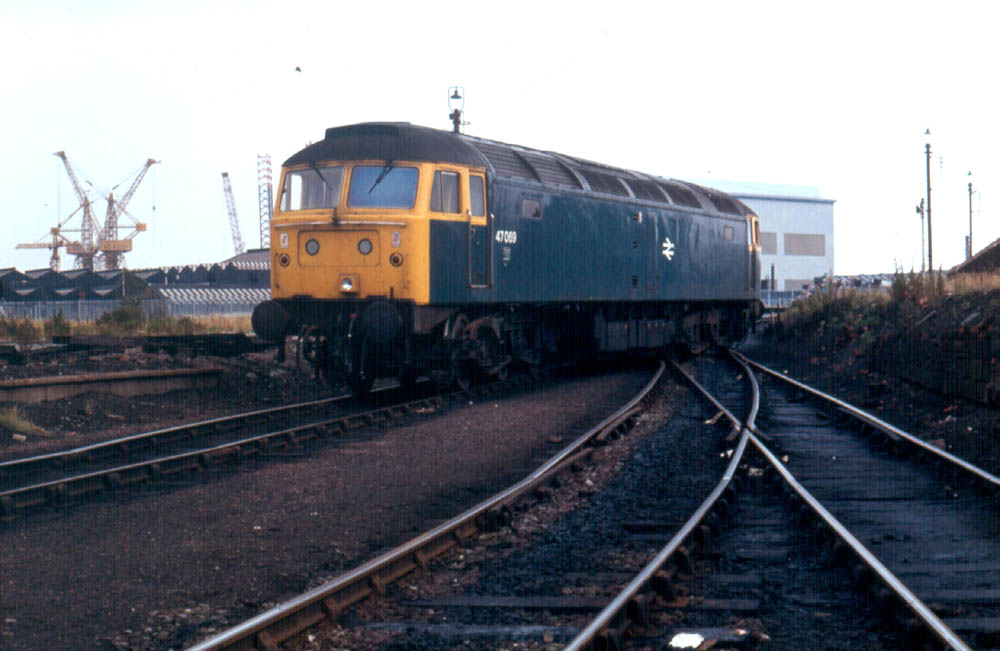
July 19th 1970 was a long day, we booked on duty at 09.45 with Driver T Roberts and locomotive 5060. I would be conducting my driver from from Bootle Junction. Our job was empty EMU stock for Hall Road. These trains were loose coupled, marked as OGLO 'out of gauge load', with a maximum speed of 20mph, hence the potential for a long day. This stock was Southport Line units, you always got three cars on these jobs, with Wirral stock you would have to use the match wagons, Buckeye coupler at one end and conventional coupling at the other. There were two brake vans with one at either end. Knowing we were going all the way with this train, we did not want to hang around, the route was via Dee Marsh, on to Mickle Trafford, Helsby, turn off the main line at Frodsham Junction, the line curves upgrade and joins the main Liverpool - Crewe line at Halton Junction. Here we wait for a clear road, down through Runcorn Station, over the Mersey railway bridge, down grade to Ditton and onto the slow line. We relax a bit now and almost immediately a passenger train flies by, plodding along past Fords sidings, past Speke sidings, through Allerton station, down to Edge Hill and round the circle line into Tuebrook sidings to run around.
Its now mid-afternoon and we need to get to Hall Road before the peak hour begins. We depart the sidings heading for Bootle branch, then past Wavertree Junction onwards across the centre of Liverpool, past Anfield then in and out of the tunnels to Bootle Junction, from here I would be conducting my driver. I take over driving, we have to wait for a clear road, our first move is out past Bootle Junction signalbox onto the slow line, then to Marsh Lane Junction, where we again wait for a clear road. Once we leave this point we are right away to Hall Road following an electric train, on past Seaforth and Crosby to Hall Road. We shunt the train onto an empty road, shut the locomotive down and go to mess room for our break, I have a chat with the shedman, who had been sent up from Liverpool Exchange, when Bank Hall closed that is where the men were moved too. On this job our guard had a conductor from Edge Hill, so we had enough men for a card school, we could not move now until the peak hour was over. When the signalman told us our time to leave we shunted our return train, and were ready to depart. Not really sure why this stock had to go to Birkenhead North, maybe for wheel turning? Off we go as fast as we can, its difficult keeping below 20mph, at Edge Hill we run around and backtrack over our outward journey to Birkenhead North, here we detach the train and run light engine to shed. It was a long but enjoyable day, signing off at 22.25.
Working freight and jobs like the one above one you spent a lot of time on the locomotive, including making many trips through the engine room etc. On passenger jobs the drivers would never see the inside of the engine room, although on the Class 40's the stove was in the engine room.
In contrast to the above job, the working on July 24th 1970 was very straightforward, taking 3102 and the Tool Van to the Docks.
July 29th we are booked on at 23.57 with locomotive 301, however we are told the outward part of our diagram has been cancelled. We're instructed to take 301 light engine to Heaton Mersey, with our guard. Straightforward trip out, parked the Class 40 on shed and went to see the foreman. He told us there was a train for Mold Junction in about an hour. We can work that, Don and the guard confirm they've signed the road to Mold. The foreman tells us to take a rest, he'll call us when the train's outside. That would have been about 02.30, at 06.00 we are still waiting and about to give up and go home when the train arrived. Its a mixed goods with locomotive 5064. We relieve the men and away we go, slow train, arrive at Arpley where we have to pick up and put off traffic. With the shunting finished we're off again, but on overtime now, slow run to Halton where we're put in the loop. We follow a passenger train from Frodsham Junction, down to Chester and on to Mold Junction. We shunt the train, told to take the locomotive to Chester depot. We park the Class 24 on the fuel track and and home passenger, booking off at 11.20.
August 10th on duty at 17.00, light engine with 1957 to Ellesmere Port West end and attach to brand new 100 ton Murco tanks. While doing the brake test I call control and ask which route from Crewe this train will be going, Nuneaton they say. I tell them we will take it to Nuneaton if there is no relief at Crewe. This was a new working, the tanks were brand new so off we go, approaching Hooton we almost pass the home signal, the brakes on these tanks were very poor, we find they are disc brakes. We run around at Hooton, off to Chester, through Crewe to Basford Hall all signals clear, out on to the slow line and off to Stafford. This was Don's railway for years, he fired the expresses up and down to London, now it's TCB, AWS and colour light signaling all the way, we get a good run through to Nuneaton. We are relieved in the station and go to the station mess room for our food. Its a very quiet room, one of those places were everybody knows one another, I did notice the big armchairs & TV, very cosy. Somebody asked where we were from, we say Birkenhead, they always ask what are you doing here? This happened quite a few times with Don at different locations. After our break we go home passenger, booking off at 5.00. The oil train was going to the Murco terminal at Bedworth.
One thing to remember when working with Don was to bring plenty of food, the days could be long, but usually enjoyable ones. October 26th was just such a day, starting off by signing on at 10.11. We're instructed to relieve a train at top of the shed and take it to the docks, detach and go light engine to Shotwick, the locomotive is 203. At Shotwick we attach to an empty train of tipplers which is bound for South Yorkshire, we would be taking it as far as Godley. This is another slow train, you just keep plodding along, the route we're taking is via Mickle Trafford and Arpley, climb the bank to Latchford, over the Manchester Ship Canal, and then trundle down through the country to Lymm, enjoyable route this, freight only line with a 40mph maximum speed. There are three crossings at Lymm, on to Cinderland, another crossing, past Broadheath to join up at Skelton Junction, with the line from Glazebrook and Northwich, on to Cheadle Junction, past Heaton Mersey to Stockport Tiviot Dale, through the old station and then climb all the way up to Woodley through the station, right at the junction and climb to Godley. Sometimes you might shunt the train at Godley, or if the electric locomotives were already there you'd leave the train on the main line short of the junction, which is what we did. We stopped by the signalbox and the signalman told Don to call control, he came back and said we're working a train to Runcorn ICI. We had our break then backed up on the ICI tanks. We departed Godley, our route would be down to Skelton Junction, take the Northwich road past Altrincham, turn off the Northwich line at Hartford and Greenbank and join the WCML on to Weaver Junction, off on the Liverpool line and down to Runcorn, then down the bank to Foley Lane and detach the train. The locomotive is taken to Garston h/S, dispose of it and then travel home passenger, booking off at 23.40.
The next day, October 27th we have a similar job, starting when we book on duty at 11.40. Today our locomotives are 7635 & 5031, light engines to the docks to take a loose coupled train to Godley. We detach here and are instructed to work back to Northwich. Here we detach the train, take the engine to Northwich shed and go home passenger, signing off at 23.20.
I was sent on loan to Aintree on December 2nd, 3rd & 4th 1970, working with a Liverpool Exchange driver and Class 08 No.3578, signing on at 21.45 and off at 07.45.
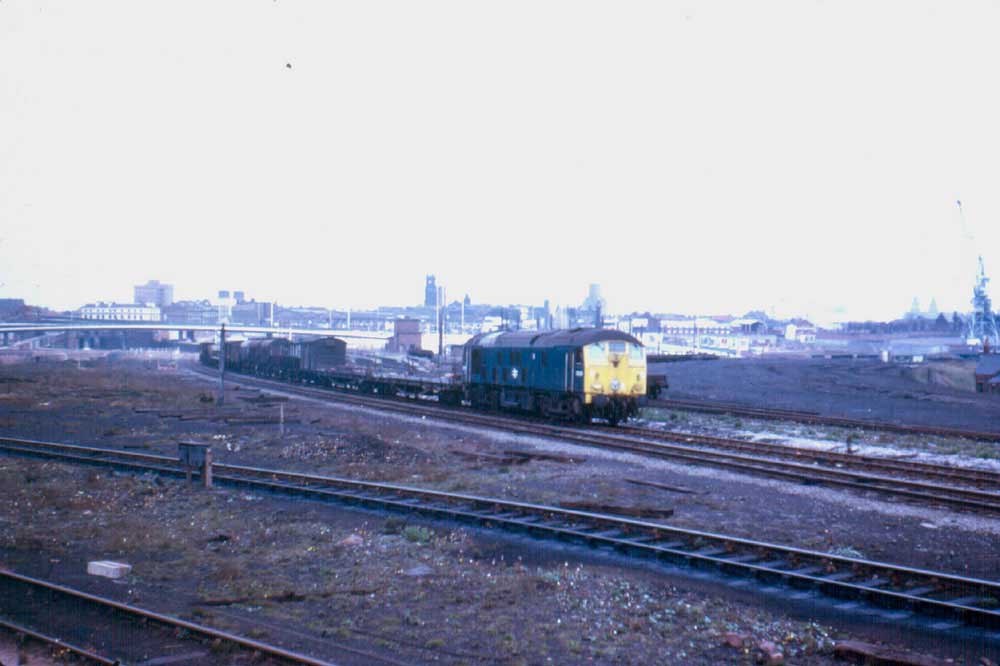
![]()
Transfer to Edge Hill
My time at Birkenhead was enjoyable, the job went from being hard and dirty, to doing nothing. Very easy to road learn now, I had a good route card, so I could conduct my driver if he did not know the route, there was plenty of overtime. The manning agreement had come out in 1965, it was very complex, the fireman was protected for mileage work & overtime etc. I was on top money at Birkenhead, with drivers working rest days, and us not yet trained on diesels we got credit and payment.
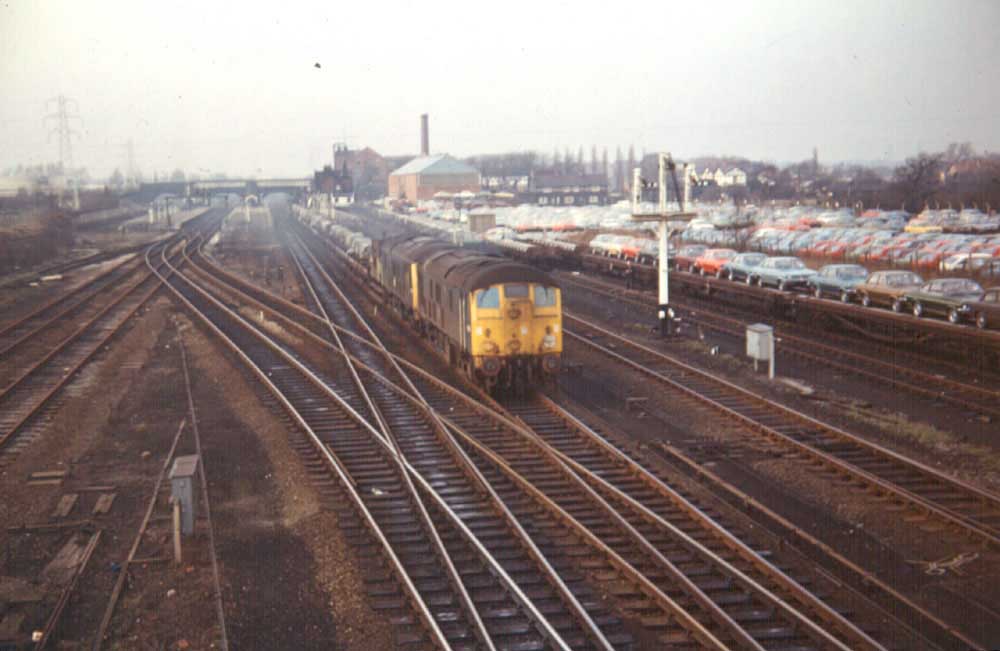
The fireman was now a secondman, and the passed fireman a senior second man, if you started before 1965 you were a starred man. They offered the firemen £250 to buy star and finish, some took the money for the future was uncertain, I studied the manning agreement till I knew it off by heart. There was no booked mileage work at Birkenhead so I was allowed a sideways move in the grade, so during 1971 I successfully put in to go to Edge Hill. This now meant taking the No.60 bus from Breeze Hill, I now lived in Brewster Street facing the petrol stations, it was my grans old house, purchased for 1,250 pounds.
The Edge Hill men had route knowledge to Leeds for the Trans Pennine workings, normal traction for the Liverpool - Newcastle diagrams would involve Classes 40/45/46/47. However on February 8th 1972 I booked on duty at 13.55 for the afternoon Newcastle job. We would work to Leeds and back. I met up with the driver who advised the locomotive was English Electric Type 3 No. 6735, and that we would have a conductor on traction to Leeds. The conductor turned out to be a Newton Heath man. So off we go on the Type 3 and arrived a little late into Manchester Victoria. Not too bad but we struggled up to Miles Platting and were late at Stalybridge. In climbing the bank to Diggle we were about about 7 mph down as compared to the Type 4's. We reached Leeds OK but just could not keep up with timings. Our return working back to Lime Street used Class 47 No. 1624.
Examples of other traction that we had on this job included:
June 14th 1971 out 1529 return 177
September 18th 1971 out 1549 return 182
February 20th 1972 out 188 return 235
September 15th 1973 out 164 return 19
December 27th 1973 out 125 return 49
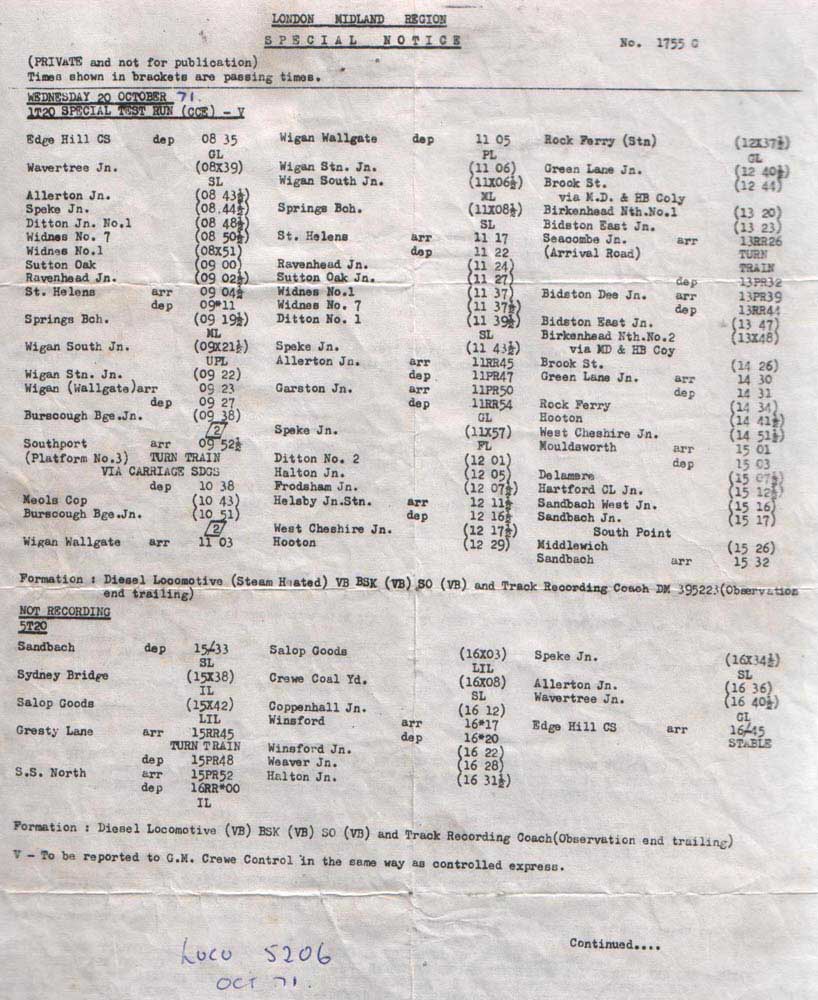
May 6th 1972 it was on duty at Edge Hill at 06.55, then light diesel to the Sidings to work to Lostock Hall with D340. We are relieved here, the Class 40 is wanted by control, we will return with a train to Ince and Elton, Shellstar or UK Fertiliser, not sure when it changed. My driver does not know the road, I arrange with Control to conduct him. Our train is coming from Carlisle over the Midland route. It arrives with D406, my driver Tommy O'Brien is familiar with the traction. Control must have been on to the Edge Hill supervisor before they asked us to work this train, or maybe they were just lucky. We relieved the train crew and worked forward to Ince, Tommy let me drive, it was a nice locomotive, but not as good as a Brush/Sulzer Class 47. We detached the train at Ince, and told to take the locomotive light engine to Edge Hill, signing off duty at 13.45.
At Edge Hill if you were on electric work you booked on at Liverpool Lime Street. The 07.00 to London was double manned whilst the 07.55 Pullman, the 08.30, 09.30 and the 10.30 were single manned so the nearest starred man could claim the mileage off whatever job. It was worth seven hours pay mileage I claimed every day, also you worked every Sunday if you wanted you were allowed to go on single manned jobs being part of your protected earnings. This situation led to the second men being the highest paid men at Edge Hill. And with me having my turns in I was only 50p short of a driver per week. This caused all kinds of envy here. I remember two drivers arriving from Bank Hall and three from Birkenhead going into the top link, nobody would talk to them. This is one reason I did not like Edge Hill.
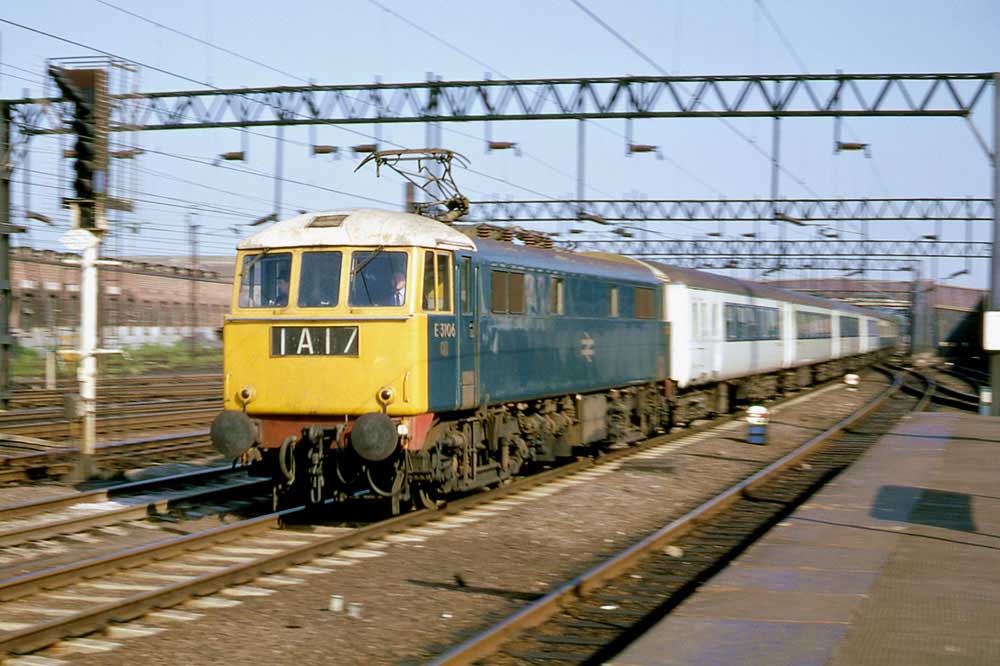
The engineers ballast workings at Edge Hill could take you to all parts of the Liverpool Division. The crew and locomotive would be under the instructions of the permanent way department. Some examples of these workings were:
April 1971, sign on 07.10 with driver T Ward and locomotive 5168 with brakevan to Southport to work a departmental train to Edge Hill, then light engine back to the depot, signing off at 17.20.
January 1972, sign on 07.10 with driver L Evans and locomotive 332 with brakevan to Wigan to then work to Northwich, attach more vehicles here and bring everything back to Edge Hill, the light diesel back to the depot and sign off at 18.15.
April 1972, sign on 07.10 with driver B Platt and locomotive 5295 with brakevan to Ince Moss, Wigan, then work to Sandhills, then engine and brakevan back to Edge Hill, locomotive back to the depot and sign off at 15.10.
November 1972, sign on 06.56 driving locomotive 5261 with brakevan to St Helens to work to Northwich, then engine and brakevan back to Edge Hill, locomotive to the depot and sign off at 16.45.
January 1973, sign on 07.10 with driver S Heyes and locomotive 5262 with brakevan to Helsby to work a train back to Edge Hill, then locomotive back to the depot and sign off at 15.10.
On April 29th 1972 I was working a job with an old mate from Bank Hall, Jimmy Carlin who had transferred there when Walton on the Hill closed, I used to go around the local clubs with Jimmy, he was a paid artist, a stand up comic. He was always booked at railway club functions around Merseyside. I had also fired for him at Bank Hall on a few occasions. The job at Edge Hill was relatively mundane, booking on at 13.35 and going passenger to Liverpool Lime Street in order to work two round trip passenger workings to Crewe with locomotives E3171 out, E3133 back then E3145 out and finally E3126 back, finally going off duty 22.00. In both cases we were relieved at Crewe.
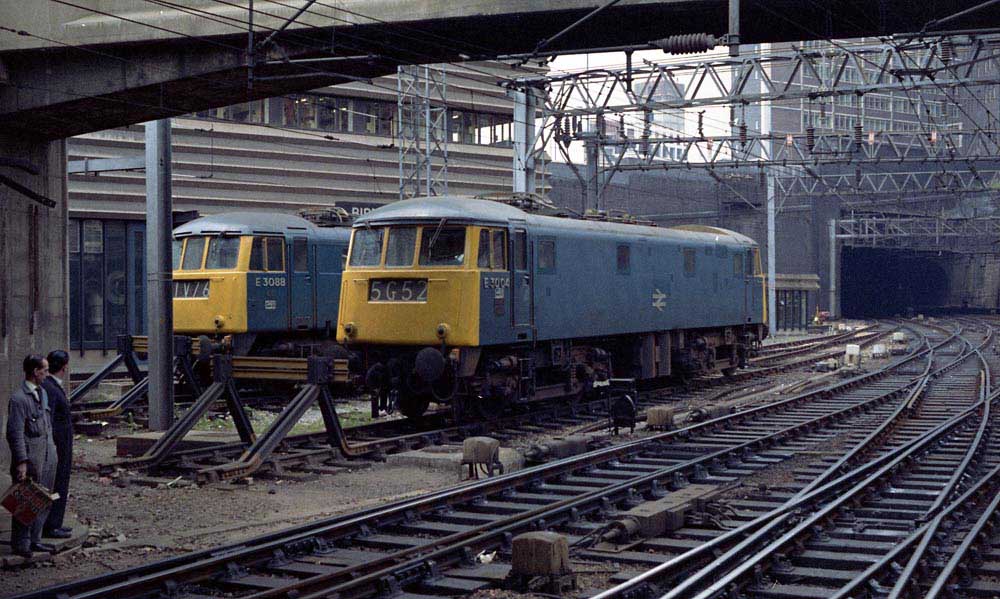
A sample week of electric workings:
Thursday July 27th 1972, 14.35 on 22.40 off - a round trip Liverpool Lime Street - London with Gordon Sutton and E3132.
Friday July 28th, 14.15 on 22.05 off, passenger to London, work back to Lime Street with Harry Morgan and E3065.
Saturday July 29th, 16.15 on 00.15 off, Liverpool Lime Street to Birmingham and return with Stan Rimmer E3105 out, E3047 return.
Sunday July 30th, 15.15 on 00.35 off, Liverpool Lime Street to Manchester Victoria and work back to Lime Street with A Smith D240 out, D1953 return.
Monday July 31st, 14.55 on 22.55 off, Liverpool Lime Street to Birmingham and return to Lime Street with Harry Morgan E3124 out, E3065 return.
On November 14th 1972 I had a driving turn out to Healey Mills. It was light engine to Edge Hill Park sidings to work across the Pennines to Healey Mills with 5241 & 5047. At Healey Mills we change locomotives and work back to Edge Hill.
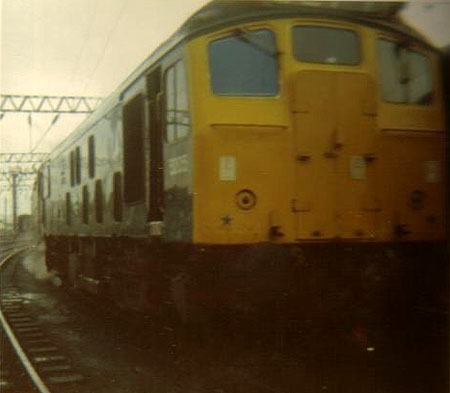
![]()
1973
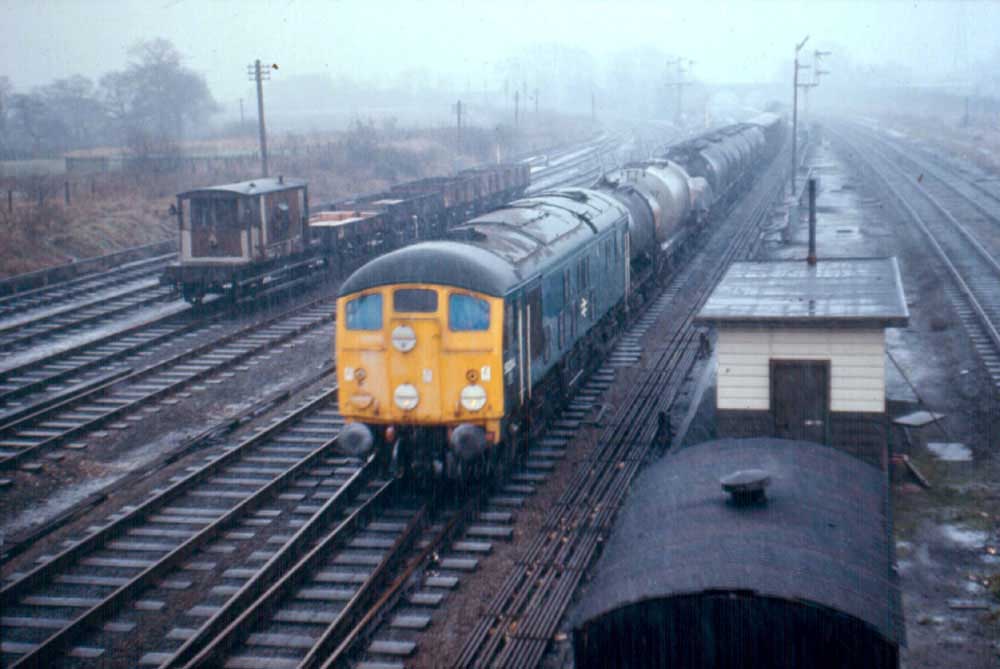
I recall 4472 Flying Scotsman coming back from USA, she stayed briefly at Edge Hill during February 1973. They fired her up, one side of the locomotive's paint was all worn off, the seaward side, I sat on the footplate for an hour talking to the minder, on February 19th it would run light engine under its own power as the 09.25 Edge Hill - Derby Works. Before the Flying Scotsman's departure I was on duty one night as the shedman's mate, my driver being a top link man, who was taken off mainline duty temporarily awaiting glasses. About 2.00am we had just stabled a locomotive and the Flying Scotsman was parked on the next road. My driver said lets go on the footplate and have a look round. She was in steam with a minder who let us come on to the footplate. At this time I had not been at Edge Hill very long, but had been advised that my driver Frankie was a bit of a character.
The locomotive had about 40lbs of steam but the minder was struggling with the live steam injector, trying to put some water in the boiler. Now Frankie, who must have been about 63/64 told the guy move out the way mate and he'd get the injector operating smoothly in no time at all. He cracked open the steam valve and adjusted the water cock, right away the injector started singing away happily, the minder looked amazed! Frank said its easy when you have worked most of your life on these things. He went on to tell me he was in the derailment of the train hauled by locomotive 6244 at Polesorth on July 21st 1947 which almost killed him.
At Edge Hill the men were trained on the Class 25's but not the Class 24's, back then however they were frequently identified in regard to their engine horsepower, either 1250's or 1160's (see below) - the types were not yet identified by the TOPs classifications. I had been trained on both, one extra day was was required for conversion to the 1160's - Edge Hill never got this training so the Class 24's were not to be seen very often. One day we were on an engineers ballast, this type of job could end up going anywhere in the Liverpool Division. The locomotive was No.5168 one of the Class 25/0's, a bit of a hybrid with the 1250hp engine but the cab layout of a 1160hp Class 24. My driver told the train crew supervisor or maybe the running shift foreman that he was not trained on the 1160's, they told him it was a 1250, I said I will conduct him. They said no need but we still took the locomotive. I often wondered who was right. Common sense told me if the loco controls are different you are not trained. What was funny was we went over the Bootle branch to Southport, my driver needed a conductor on the road from Bootle Junction. The emu driver conducting took the controls with the consent of my driver. The driving turn would have meant 50p to me. But this was what Edge Hill was like, anything to stop the senior second man getting a driving turn, mind you they probably did not know I was already on my top rate. When we signed our card for the traction there were no TOPS's numbers so my card would have read 1160's on one line, below would have been 1250's for separate signing. So the running shift foreman on my drivers occasion was trying to say you have signed for 1250's, which he had but was not familiar with the cab layout, as on 5168 - a bit of a grey area. The foreman should have known better, but that's what happens when you get a foreman not from the line of promotion. This happened quite often, they did not understand the practical side of the job. So you would have to say 5168 at the time was a 1250 locomotive with an 1160 cab, more confusing!
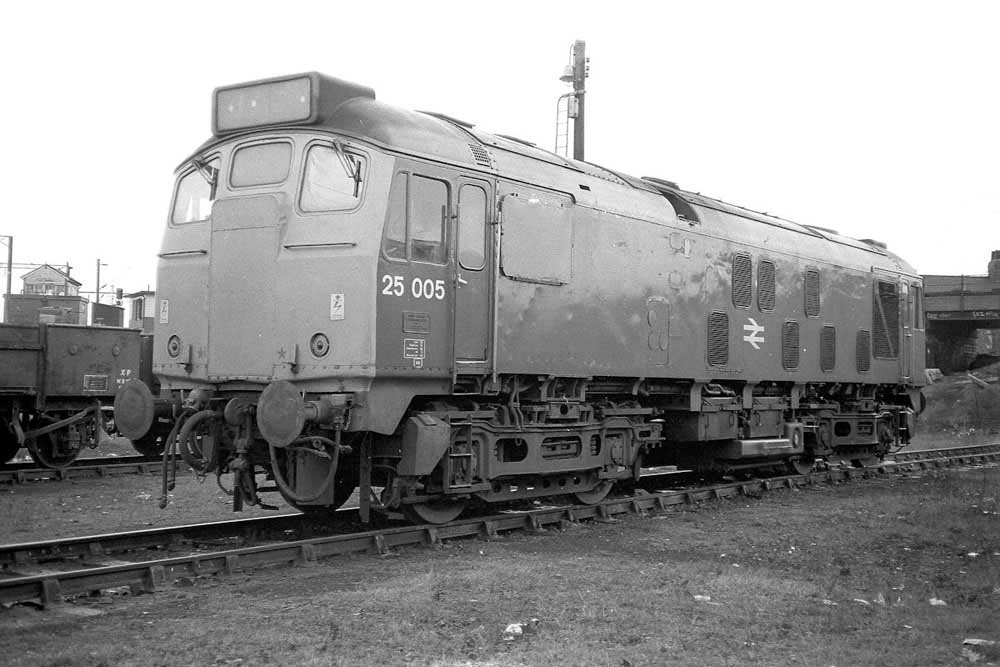
I enjoyed the London jobs, most drivers would let you drive. A few weeks after the Flying Scotsman incident I was booked on the 17.25 Pullman, first stop Runcorn, then Watford and Euston, this train was at one time the fastest timed passenger train on the LMSR. Anyway its two minutes to departure from Lime Street and there is no sign of Frank, my driver. I was looking down platform and there he was alongside the dining car being handed a cup of tea out of a window. Without breaking his stride he took the tea, reached the locomotive, stepping into the cab just as the departure flags and whistles occurred. He sat down at the driver's desk and we were away! After leaving Runcorn Frank said get in the drivers seat. I was still getting used to the road beyond Crewe and the handling of the neutral sections, which required you to take the power off as you passed through these sections. Now in the driver's seat I heard Frank open the engine room door and vanish but I kept my cool, I remember approaching Stafford with its speed restriction round the curves, then through Shugborough tunnel and on towards Colwich, at which point Frank reappeared in the cab and asked how I was doing? Despite the sweat on my brow he kept me in the driver's seat until Rugby, where he took over for the remainder of the trip up to London.
Whilst at Edge Hill I worked with two of the fireman involved in the tragic Harrow & Wealdstone crash in 1952. Both had been on the Down Liverpool express which this day had been double headed. George Cowper had been the fireman on the leading locomotive 45637. His driver was killed in the crash whilst George was thrown from his locomotive and ending up on the splasher of the train engine 46202. The fireman on 46202 was another George, George Dowler.
On May 9th 1973 it was on duty at 21.45 taking a light diesel, in this case D169 up to Liverpool Lime Street. From here we would work to Stockport, on this job you were booked to carry two of the catering staff from the Adelphi Hotel, Liverpool and put them off at Widnes, the two ladies always brought some very rich cake or gateau to give to the traincrew. The locomotive on this diagram was off the day's last inbound Newcastle, always a Gateshead machine. The route to Stockport was via Glazebrook, and Skelton Junction, after detaching at Stockport you would go light engine to Manchester Exchange and attach to the newspaper train, and have your break. Then we would work forward to Broad Green and detach the newspaper vans at the distribution center, then on to Liverpool Lime Street I think. The locomotive was diagrammed to work the first Newcastle back. We were off duty at 05.45.
I liked the class 45's and 46's on the Newcastle jobs, we also had the class 50's on the Glasgow turns with two in multiple. We had the Healey Mills job of a night, we went to Birmingham via Chester on Sundays, the drivers went daily single manned, four jobs daily, four hours mileage on those jobs, because they were new jobs they could not claim mileage. When a man from the shed covered one of those jobs an hour was added on to diagram, I said he's on overtime so has to be double manned, they said overtime was not counted. It was passed on to the union rep and a week later all Birmingham and EMU jobs covered by the shed became double manned, more mileage payments, so this star paid thousands for me even union reps were envious of secondmen. Management did not like me.
The summer of 1973 brought the first sign's of the TOPS locomotive renumbering, initially with the electric fleet. Mal recorded his first observation of this on August 13th 1973 when 86201 was noted. The first observation for Mal of a renumbered diesel was 46045 on November 30th 1973.
Despite the thinning out of BR's diesel fleet it was still possible for the train crews to encounter quite a variety of traction during a week's diagrams. Early in September 1973 Mal encountered quite a variety of traction as detailed below:
September 9th sign on 23.15, light diesel to Liverpool Lime Street to work train to Preston, detach here and light engine back to Edge Hill, sign off 06.00, the locomotive was 428.
September 10th sign on 20.20, light diesel to Park Sidings to work a round trip to Healey Mills, sign off 06.50, locomotives - out 249, return 5263.
September 11th sign on 19.40, on Banking engine to Foley Lane and ECS, off at 02.00, locomotive was 1944.
September 12th sign on 22.00 - Ferry Set, Off 06.00.
September 13th - Rest Day.
September 14th sign on 17.20 at Liverpool Lime Street to work to London, then back to Crewe and home passenger, sign off 01.20, electric locomotives, out 3130, return 3066.
September 15th sign on 14.05, light diesel to Liverpool Lime Street to work a round trip to Leeds, signing off at 22.05, locomotives - out 164, return 19.
September 16th sign on 12.55, light diesel to Down Hill sidings, then ECS to Manchester Victoria via Wigan and Atherton, home passenger and sign off 19.55, locomotive 355.
September 17th sign on 12.57, second manning an EMU Liverpool Lime Street to Crewe, two trips with the driver on overtime, sign off 21.50 - Emu 047.
Two of the above workings require further explanation - the September 12th ferry set move, as they called it at Edge Hill was a set of men who would book on at 06.00, 14.00 and 22.00 for any light locomotive (diesel or electric) movements from depot to depot, or any unscheduled train movements.
The September 11th banking engine move involved visiting Folly Lane on the Runcorn Dock branch. The branch was accessed from the Crewe direction south of Runcorn station using the the down line with the branch begining at the west side of the station, then past the signal box and a big looping curve to the west downgrade to reach Folly lane, about half a mile to the freight yard for ICI traffic, the overhead wires ran down to the yard. We were booked to bank a heavy mixed freight train up on to the main line, electric hauled, a diesel or electric locomotive would be used for this banking job. The ICI complex was close to the yard. Because this train had to be banked every night they made a booked turn for it, when arriving back at Edge Hill you could be asked to do anything, on that occasion we handled a run of empty stock.
My first Class 87 was on October 1st 1973, booked on 14.50 with Driver W Hulme to work Liverpool Lime Street to London with E3124. The return trip was with 87001 and I was driving. En route back around Bletchley we started getting checked, 2 yellows, 2 yellows, reducing speed to around 70 mph. With this combination you would know you were behind a freightliner. Wilf said don't worry, he'll put the freightliner over to the slow line at Handslope on the high speed crossovers. Surprisingly this did not happen, instead we were signalled over to the slow lines at Handslope. This meant we were going via Northampton, I said to Wilf what should we do? He said keep going, they must know what the're doing. We lost more time with the train going that route but nothing was ever said.
On Tuesday October 23rd it was the turn of 87002 to work from Lime Street to Euston, the return trip was with E3126.
![]()
Back to Birkenhead (1974 - 1980)
Despite all the adventures at Edge Hill I was looking for a move back to Birkenhead whenever a vacancy opened up. This occurred in February 1974. Edge Hill left me with many memories, but the mileage work had caused jealousy. The work was very different. The electric locomotives were clean and quiet, but different when compared to steam and diesel, they seemed to be alive, but the electrics were dead. The work however was incredibly varied, one day you could be off to Leeds with a Newcastle train, next day an engineers ballast train anywhere in the Liverpool Division. The next off to Birmingham New Street and back north with a Class 50 to Preston. On one Sunday I took a diverted passenger train into Birmingham New Street with a class 50, the the crowds of spotters around the locomotive were amazing. There were also the Down Hill sidings coach trips, trips to the docks or off to London and back. Freights would go to Healey Mills, Godley, Crewe and then there were the parcels & paper trains.
There was also the Newton Le Willows - Stirling motorail, another train that's vanished. A shortage of DMU's led to diesel hauled substitutes, in particular I remember Class 45 D100 'Sherwood Forester' working two trips on the stopping service to Wigan, there was always plenty of interest at Wigan.
Occasionally you'd get the chance to handle officers specials, this is where I met R N Hardy, the Liverpool Divisional Manager, a nice man with a great interest in railways, whether on or off the job. Whilst waiting to depart Euston, Mr Hardy walks up to the locomotive, he always liked to travel on the footplate. My driver said 'Get in the chair'. So off we went, we were turned on to the slow line at Bletchley, then later back to the fast, the speeds over the junctions were tricky, but Mr Hardy managed OK.
I did bump into Mr Hardy again when I had the chance to handle the Officers specials, during my time at Edge Hill & Birkenhead I worked at least four of these trains mostly because of my considerable route knowledge, he liked to have one crew throughout the job. When you stopped for lunch, they carried their own chef, Mr Hardy would invite the crew to join them for lunch, which was most excellent especially when washed down with a bottle of beer. I remember we stopped in the siding at Delamere Forest at least on two occasions.
For me being a booked driver meant little, the difference in pay was minimal. My route card was now quite extensive; London to Carlisle, Birmingham, Leeds via Summit and Diggle, Wolverhampton via Salop, most of the Manchester Division, the nearest I got to your webmaster's neck of the woods was Eggington, with a Crewe man as conductor from Stoke.
Late in 1974 I was sent up for EMU training, something I'd avoided for awhile, I did not like the EMU jobs. They including working the steepest bank in the country, the 1 in 27 from Hamilton Square down to the Mersey river bed. Also signed Hall Road and Horwich, this would permit taking empty stock and EMU's for paint jobs and exams at Hall Road.
The following is a list of turns (in no particular order) that Mal remembers working from his time at Birkenhead, some of these are mentioned more fully in the text. Some of these jobs would be worked throughout, whilst others would only be handled for part of the journey;
Haydock oil distribution depot, accessed off the WCML between Golborne and Bamfurlong.
Whittington oil distribution depot on the Salop line.
Oakleigh, Lostock, Wallerscote, Winnington, ICI Northwich area.
Ravenhead, Cowley Hill, Pilkingtons glass, St Helens.
Holywell, Courtaulds.
Runcorn Foley Lane, ICI complex, next to Runcorn station.
Salfords, Gatwick, aviation spirit.
Cliff Vale, Stoke on Trent, gas oil.
Burn Naze, Fleetwood, ICI complex.
Iron bridge, Telford, power station.
Widnes, Chemical complex.
Dewsbury, gas oil power station.
Moretons, Tibshelf, ?
Albion, Tipton, Wednesbury, ?
Pontefact, bitumen.
Elswick, bitumen.
Newcastle, bitumen.
Bardon Hill, bitumen.
Ecclesfield. ?
Braintree, Shell fertiliser.
Greetland, fuel distribution.
Grange/Etruria, iron ore.
Bathgate, Vauxhall cars. Hooton, Bathgate, ran for three years.
Delmarnock, heating oil.
Wath, scrap iron.
Toton, diesel fuel for depot, once, every week.
Bedworth, Murco, ?
Liversedge. Mobil.
Bestwood Park, slack for Bowaters.
Worksop ?
Torkskey, ?
Tipton grey tanks, a small loading facility existed at Mollington (near Chester) which closed after Stanlow opened.
Rowley Regis, oil - almost daily, lighter trains routed via Shrewsbury, heavier workings sent via Crewe because of Gresty Bank.
Oil Trains
Shortly after I arrived at Birkenhead shed the Stanlow ground frame had just opened eight roads under the fuel rack fillers, which produced plenty of new tank trains, requiring more drivers passed for steam locomotives. I can remember the Leeds tanks which were double headed with a Black Five and a Class 9F. Naturally the entire area around the fuel racks was smothered with no smoking signs, which became a little out of place as we pushed out of the sidings sending huge showers all over the place, including the fuel racks!
Stanlow Ground Frame had recently opened, for aviation spirit, heating oil and petrol trains - grey tanks for spirit & black tans for heating oil. Stanlow East white tanks were butane and propane gas. Two miles beyond Stanlow was Ellesmere Port, east end black tanks for bitumen and Octel chemical tanks, tripped by Manchester Ship Canal locomotives from Eastham Docks further up the line. Beyond Ellesmere Port station was the west end yard, Mobil oil tanks and Gulf. Also Bowaters slack trains from Bestwood Park, we took the empties to Stoke, Midland men sometimes worked forward to Ellesmere Port with two Type 1's. Every night Healey Mills men would work Mobil empties in with English Electric Type 3's and take loads back to Liversedge, the 30 ton tanks disappeared by the early 1970's. We had all 45 & 100 tonners.
The two views below are out of order timewise but illustrate places mentioned in the text above.
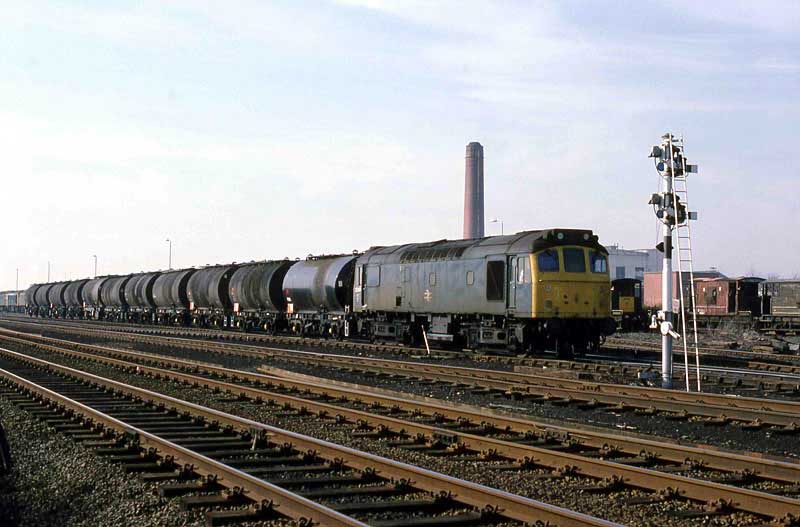
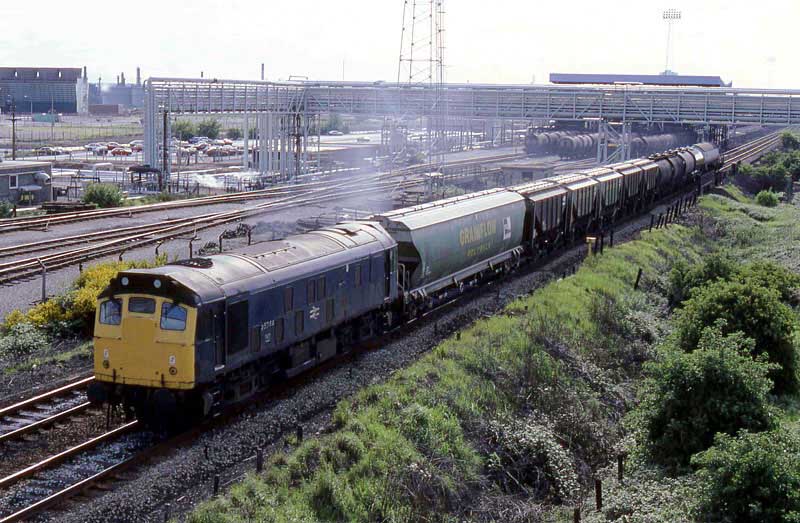
As well as shipping out various petroleum products we also handled trains of crude oil in to Stanlow for refining, provided by small wells at Tuxford, Gainsborough and Wareham. These were conditional trains that ran when required and one of them early in 1969 nearly caught out my driver and me. This was before TOPS and freight loading coming in to being. We attached the Class 47 to the Tuxford tanks at Guide Bridge with four vans as runners. The guard came up and told us how many cars we had on. So off we went thinking they were empty. Jimmy was driving and we had a good road, just rubbing the brakes slightly to control the train as we approached Heaton Norris Junction. Here we get one yellow, Jimmy gives her more brake but nothing happens, then full brake but we are still going 30mph!
Fortunately enough road is set for us over the bridge into Stockport station, we finally came to a stop south of the station under the bridges. I jumped down and checked the tanks, they were loaded, so off we went at reduced speed. No wonder they brought the freight loading out not long after that.
Another time we attached tanks at the west end of Ellesmere Port. These were brand new Murco Oil tanks, I'd never heard of it. So we head off to Hooton to run round and almost pass the home signal at Hooton, these new Murco tanks had disc brakes which only worked on one half of the car, similar to the merry go round trains.
From my notes during April 1974 several times we worked the Stanlow - Leeds oil tanks as far as Newton Heath, where we were relieved. On the Monday we had 40155 so we called for a banker to assist us at Miles Platting, we stop on the bank clear of junction, the banker buffers up at the rear and off we go. On the Wednesday we have the same load but 47270 is our locomotive. We charge at the bank through Manchester Victoria, past the 1 in 59, past the 1 in 47, on to Miles Platting, no problem! On the Thursday we again get 40155 with the same load and same weather conditions. So again we charge up the bank, passed the 1 in 59, onwards, now slowing down with our fingers crossed, on to the 1 in 47, slow, slow, then stopped with no chance to pull away. Now somewhat embarrassed the signalman is called on the phone, he sends the banker up and off we go. Of course we had to try it with the Class 40, but nothing is said.
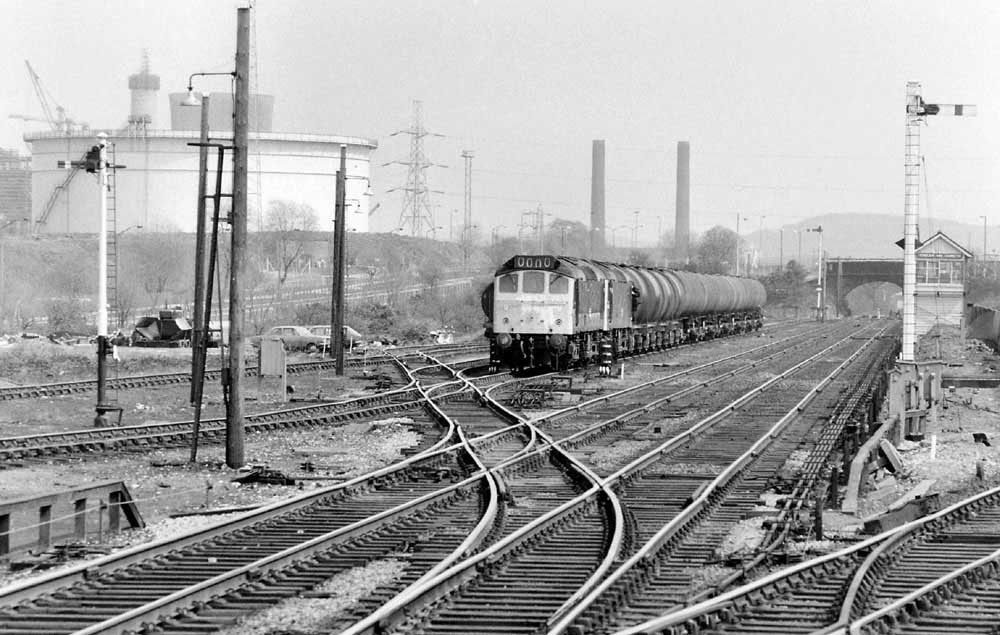
Iron Ore
Early one morning two Class 24s in multiple were prepared at Birkenhead and taken to Bidston Dock in order to work the Shotwick trips. They were left here and taken up later for the diagrammed Shotwick working. Whilst they were coming down the bank from Heswall the driver's thinking there's not much of a brake on these locomotives, or possibly the guard is not using his handbrake. With the train now out of control, the driver starts popping the horn as he approaches Shotwick sidings, the signalman keeps him on the mainline. The train is now approaching Dee Marsh and the driver had jumped off the train. With the speed now down to about 10mph the signalman had asked some Croes Newydd men to bring the train to a halt with their locomotive. They started moving just as the slow moving runaway train touched them, bringing everything to a stand. Good railway work. When the locomotives were checked everything was attached except the brake pipe, leaving only the locomotive brakes working, which had operated once the driver had jumped off the still moving train, thereby releasing the drivers safety device pedal.
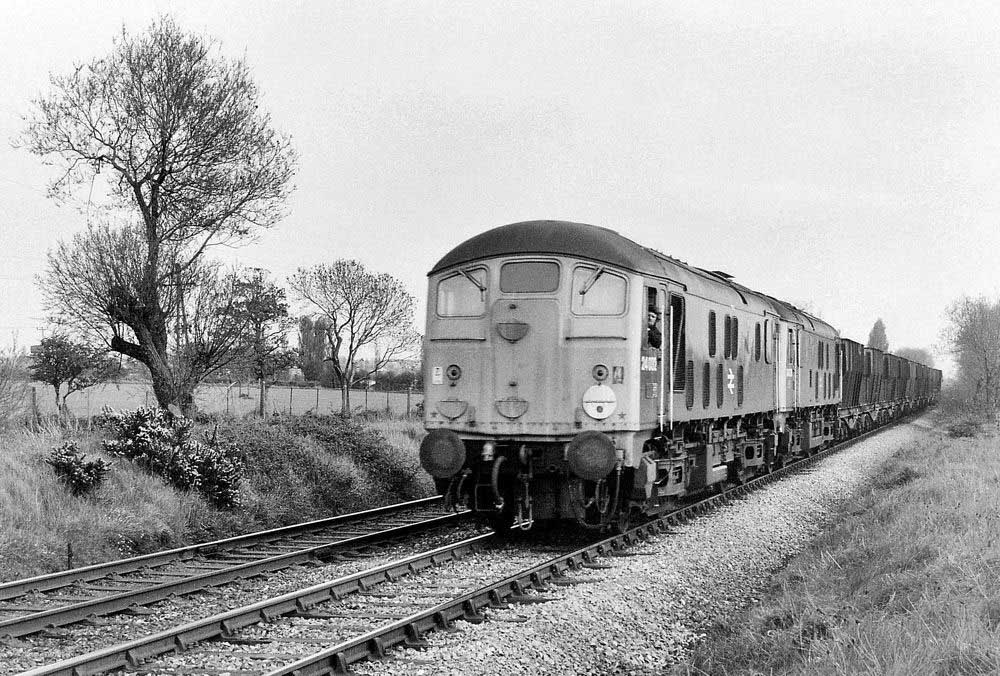
During July 1975 improvements commenced on the electric services that ran from Liverpool, under the Mersey to Birkenhead, Bidston and West Kirby. July 28th saw Liverpool Central Low Level closed to allow work to commence on the new loop. During its closure trains were turned back from James Street. My first trips in the morning rushhour were an eye opener. The EMU shedman would go down to Low Level from Birkenhead Central. As you arrived at Low Level and came to a stand, (six car units in the peak hours), you'd shut down the cab, reverse the running lights and step out of the cab. At the same time the EMU shedman would enter the other end cab and propel the train down into the neck. You could see the signals as you walked down the platform. When you reached the top end, your train would pull up beside you. He would then step out and walk across to the next train in and start the process all over. By now you'd be back in the cab and off you went. The process worked like clockwork, after the peak the EMU shedman would make his way back to Birkenhead.
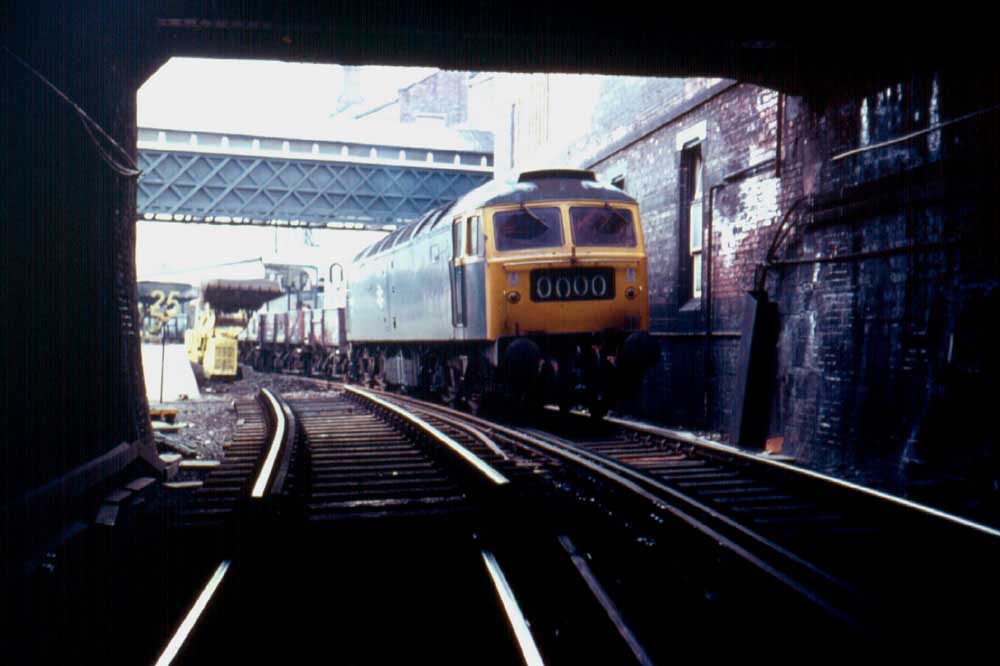
On December 16th 1975 we were working the usual eleven hoppers from Shotwick sidings to Bidston Dock. On this occasion it was single line working into dock because the other line was under maintainance. We ran on to departure side sidings and detached the locomotives. We thought we had the yard to ourselves, my secondman was driving at the time, our locomotives were Class 24's numbered 24135 and 24140. At about 06.30 the signalman had let two more locomotives into yard which resulted in a collision between the two sets of locomotives. From our pair 24135 sustained cab damage, as did 24089 from the other pair, also receiving serious cab damage. We then split the locomotives and put the two good ones together, and shunted the two damaged ones to a siding. For this incident I recieved a one day suspension, the driver of the other two locomotives had panicked, instead of setting back he jumped off. The two damaged locomotives were subsequently stored in the old GWR shed at Mollington Street until being sent down to Swindon Works for scrapping.
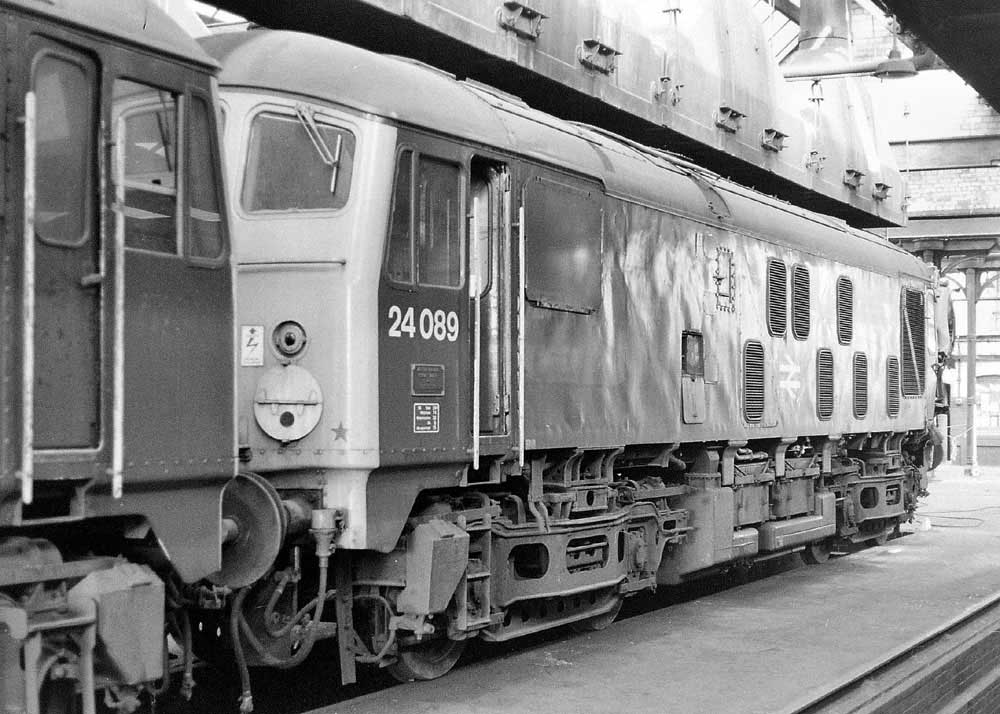
The Class 40s were great looking locomotives, but were notorious for picking their wheels up and skidding, the hand brake was useless as mentioned earlier with the incident at Heaton Mersey shed. The fan at No.1 end when drawing in air would create a considerable draught through the cab windows, we had to hang our coats by the windows to stop the draughts. The cabs originally had fan heaters, what a waste. These had to be replaced with electric heaters. The sanding gear was also a challenge, frequently you'd press the button and nothing would happen.
On 12/2/75 we had the 9M72 Whitwell to Shotwick with locomotive 40003. The train had arrived at Godley Junction behind two Class 76's, we worked forward from here with 40003 at a maximum speed of 25 mph, there was no fitted head. To descend the bank at Brinnington some wagon brakes were pinned down at Woodley. We set off down the bank passing Bredbury distant signal, on approaching Brinnington I could look down the bank and see the signal was set to go into the loop.
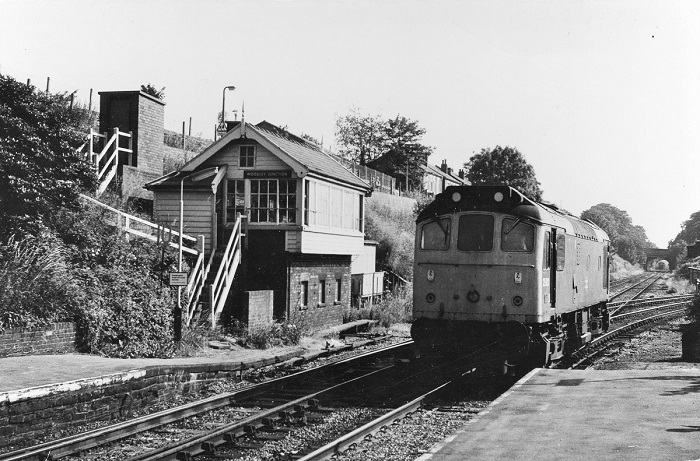
At Brinnington as the locomotive entered the loop I remember the young signalman in the box gave a wave, with 3 or 4 wagons in the loop and with 20lbs pressure on the independent brake the wheels picked up, and we started skidding. The only option was to pop the horn, and hope the young signalman would turn us out onto the main line at the end of the loop. The speeds picked up as more wagons entered the loop, pop pop pop went the air horn all the way down the loop which had a set of trap points at the bottom.
The route had not been set back to the main so I picked my place to jump off the locomotive which was just before the bridge at the bottom. 40003 ran through the trap points and tipped over almost on to her side whilst the first four wagons of sand derailed, I was about six wagons back so had a lucky escape. The locomotive was still running so I climbed on and shut it down, grabbed my bag and started to walk towards the brake van. Reaching the guard I told him we were derailed, he said, 'this is true, I thought I felt a bump'.
We walked to the signalbox, the young lad was panicking. I told him to calm down, nobody had been hurt. He said the Woodley signalman advised him to put us in the loop, in order to allow a fitted Fiddlers Ferry train go by. Every signalbox had local instructions, unique to their situation. For Brinnington box the local instruction was to stop the loose coupled trains on the mainline and run the fitted trains around him on the loop. The young lad did not know this. Later Control said they were sending two Type 2's off Heaton Mersey shed, and asked if we would take the train forward. Which we did as far as Northwich, and travelled home from here passenger.
The signalman had also asked if the derailed 40003 was clear of the mainline, I said yes, then the Fiddlers Ferry train turns up and stopped by the unfortunate 40003, I said what have you stopped for? The driver asked 'Is it clear?' I remember saying of course its clear, don't make things worse, so off he went. After the incident a report was filed but not another word was heard about the matter.
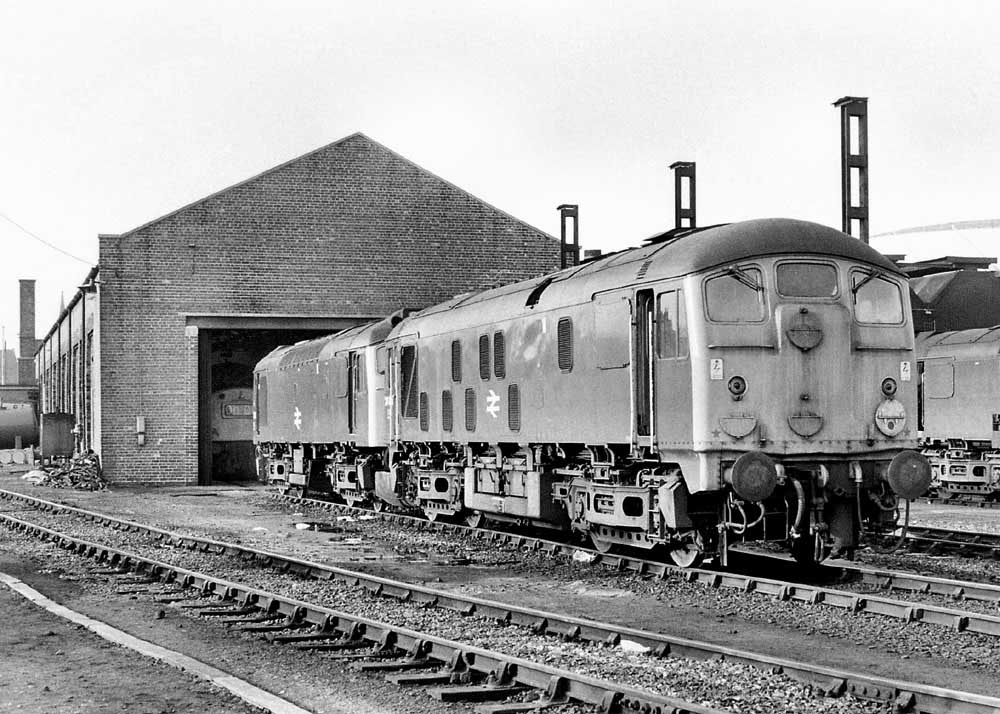
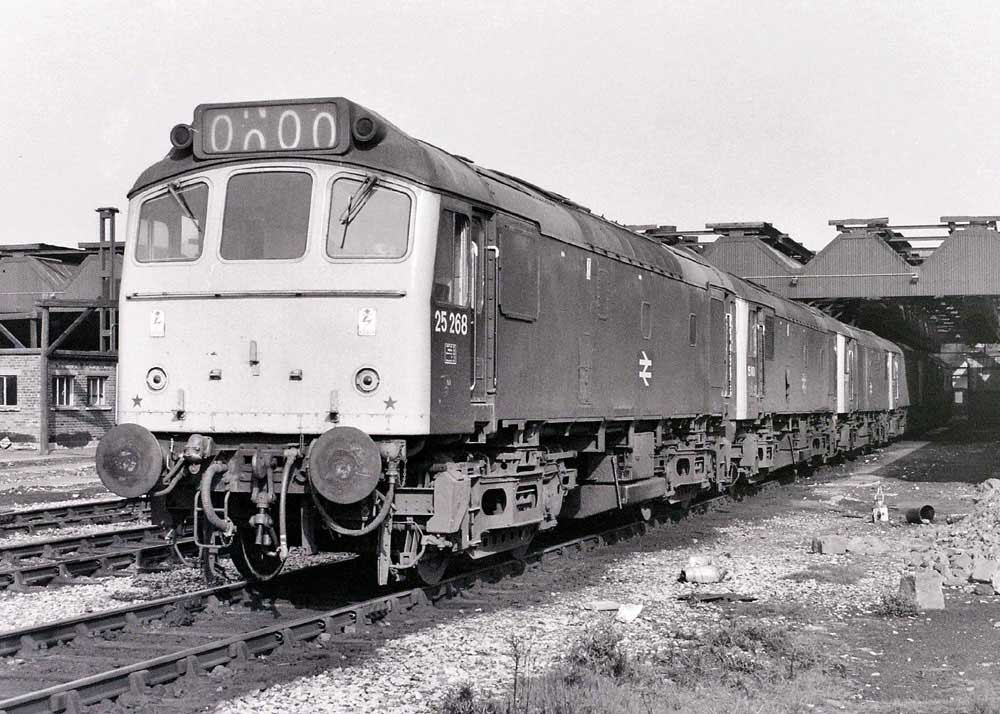
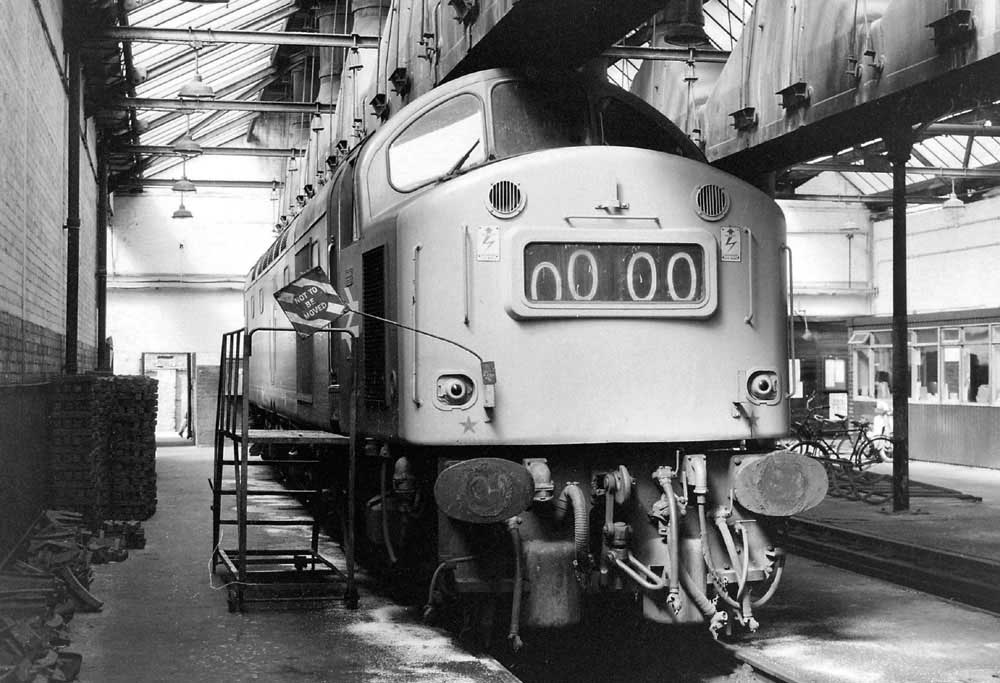
Mid January 1976 found a week's work on the Stanlow - Haydock job (see story below for greater detail on this working). Signing on was at 15.45 then light engine to Stanlow. A loaded train was taken to Haydock and in most cases empties were returned to Stanlow, then light engine back to Birkenhead. At this time this working was diagrammed for a pair of Class 25's.
On January 19th 25298 & 25279 were on the Haydock job with sign off at 03.45. The next day the combination is 25298 & 40177, there are no empties to bring back, so the locomotives return light engines to Birkenhead, sign off is at 00.10. January 21st is similar to the 19th, this time with 25298 & 25296, signing off at 03.05. The next day is almost the same except we go passenger to Stanlow to pick up the train, now with 25283 & 25200, the rest of the diagram is as expected, signing off at 01.40. The next day (23rd) is as expected except instead of two Class 25's we have 47250, sign off is at 02.10. A single class 40 was not powerful enough for this job, when you left the WCML main line to join the remnants of the single line to Haydock, the steep grade was too much. Also the climb from St Helens was steep enough to tax the locomotives. When you had a Class 25/40 combination it was necessary to man both locomotives.
During the summer of 1976 the Bidston Dock terminal - Shotwick sidings iron ore trains were running generally seven days a week, dependent of course on the arrival of the ships at Bidston Dock. A sample of the timetabled workings (except Sunday) are listed below:
Loaded 'up' workings - Bidston Dock to Shotwick
9F11 00.04MX
9F10 01.40
9F12 03.18 conditional
9F13 04.24
9F14 06.51
9F15 07.30 conditional
9F16 09.38
9F17 10.32 conditional
9F18 11.35
9F19 13.38
9F20 15.06
9F21 16.57
9F22 19.25SX
9F23 20.35SX
9F25 22.56SX
Empty 'down' workings - Shotwick to Bidston Dock
9F27 01.27MX
9F28 03.03MX
9F29 05.54
9F30 08.58
9F31 11.01
9F32 12.58
9F33 15.01
9F34 16.44
9F35 18.44
9F36 20.52SX
9F37 21.58SX
9F26 00.19MX
With the active fleet of the Class 24's rapidly diminishing the workings were now regularly handled by pairs of Class 25's. Mal worked the Shotwick trip on August 31st which meant signing on at 18.23 and picking up 24080 & 24047 for the trip, signing off at 02.20. These two Class 24's remained on this service for the following four days. For 24080 time was very short, within a month it would be withdrawn from service.
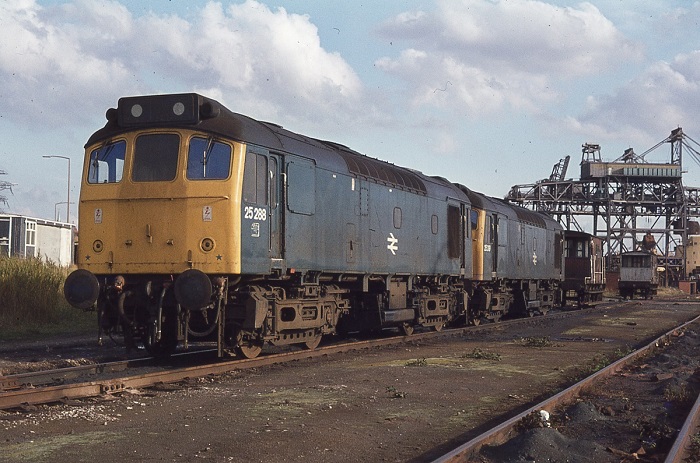
At the beginning of November Mal was working the Shotwick trips for four days, signing on at 04.46, signing off at 12.46:
November 1st 25279 & 25053
November 2nd 25156 & 25130
November 3rd 24057 & 25167
November 4th 25130 & 25156
During the summer of 1977 we noticed that there were more Class 25's on our trains, instead of the Type 4's. Typical of these workings included 25284 & 25317 on September 19th 1977 with a Stanlow Iron Bridge, Buildwas and return to Stanlow. Four days later it was 25130 & 25306 running from the docks to Etruria then light engines to Cockshute. On November 29th 1977 the diagram used 25287 & 25296 for a Stanlow - Preston Dock job then light engines to Springs Branch.
The Class 24's were still regular visitors to the Birkenhead area, Mal's notes indicate that on September 6th 1977 24073 was used on the Hooton ballast, signing on at 09.08 and signing off at 16.08. On September 23rd 24087 was on duty with a ballast train.
On a visit by your webmaster to Birkenhead on a gloomy November 20th 1977 it was observed that the shed master was having to deal with 40054 which had jumped its parking brake and possibly hit the shed wall. Mal comments the the Class 40 handbrakes were useless, they should never have gone into traffic with them handbrakes. The locomotives carried two chocks, but they were not much use because instead of being sharp ended they were blunt. After many mishaps they changed them to sharp ended, which could be better wedged under the wheels. In 1968 we had one run off Heaton Mersey shed. The Class 40 handbrakes were set and utilising two chocks of the old type, my driver was a diesel instuctor. The Class 40 went through the trap points at the shed outlet.
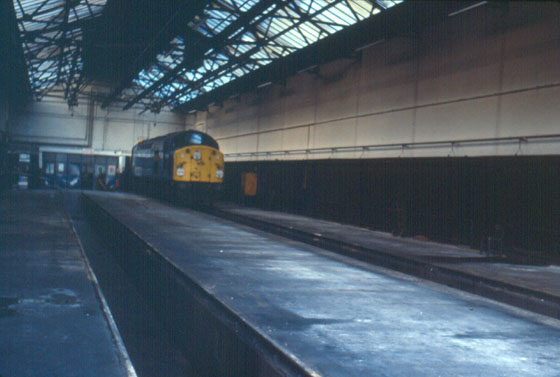
Late in January 1978, on the 27th Mal worked 24023 and 25156 as light engines to Edge Hill fuel and inspection point and came back with the same locomotives. At this time 24023 was the elder statesment of the Class.
The Stanlow - Haydock was being run regular with Class 25's - on May 18th 1978 we had 25318 & 25307 for the round trip. We pushed out from Stanlow then down to Helsby, through to Warrington, off the mainline at Winwick Junction, on to Earlestown, down to St Helens Junction, round the curves to Sutton Oak, past Ravenhead, on to Shaw Street round the 30mph curves east of the station. At this point the Class 25's would be challenged by the bank with their train of ten 100 ton tankers. Once over the bank it was down to Ince Moss and round the curve towards Bamfurlong and join the slow line. Access to the former GC line was over a new connection added in 1968 from a lead off the northbound line.
On this particular Haydock job on the way back down the single line with the empties, we were waved down by police, I opened the cab window and asked what they were doing on the track. They advised we had run over a schoolboy and he'd lost his leg. I had no telephone to contact control so I stepped down from the Class 25 and explained to them that we not seen any schoolboys. They initially couldn't understand that we were not aware of what had happened. However another policeman walked up and advised us a woman in a house nearby had seen two boys jumping on to the rear of the tanks, she said they frequently did this. However this day one of the boys had slipped and his leg had gone under the wheels of a tank. I remember the tanker drivers at Haydock had a collection to assist the family of the schoolboy.
At Haydock you would stop your train alongside terminal and then run around the train. There were two tracks for unloading fuel, the guard would stop you when tanks were spotted. Then you would detach, go to the next road and pick up the empties. Same move again and ready to depart. On another occasion on one of these jobs one of our guards was making the moves in the dark and signalled the driver to pull forward with the empty tanks. Unfortunately some were still being emptied, black oil went everywhere around the fuel racks. For weeks later we were supplied with wellies on this job. (Mal's friend Arthur later reminded him that the guard on the Haydock job when the oil slick occurred was Les, who features elsewhere in these memories, and that the wellies were supplied by the signalman at Bamfurlong Junction).
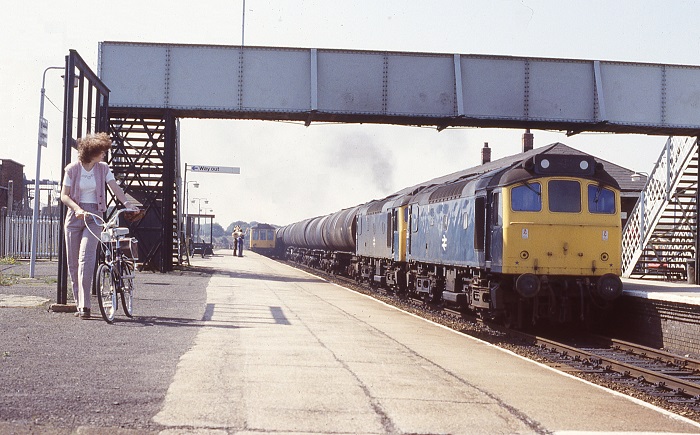
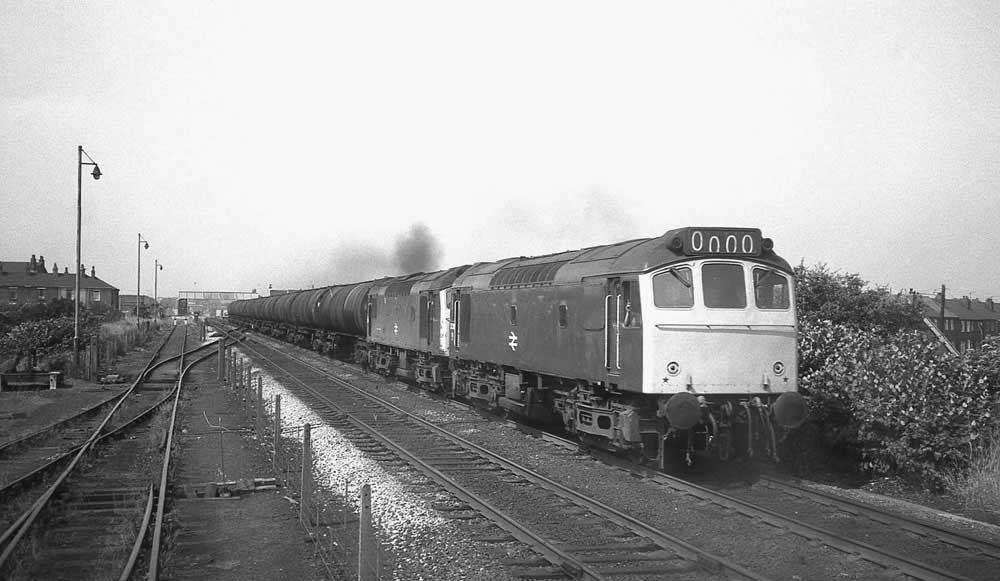
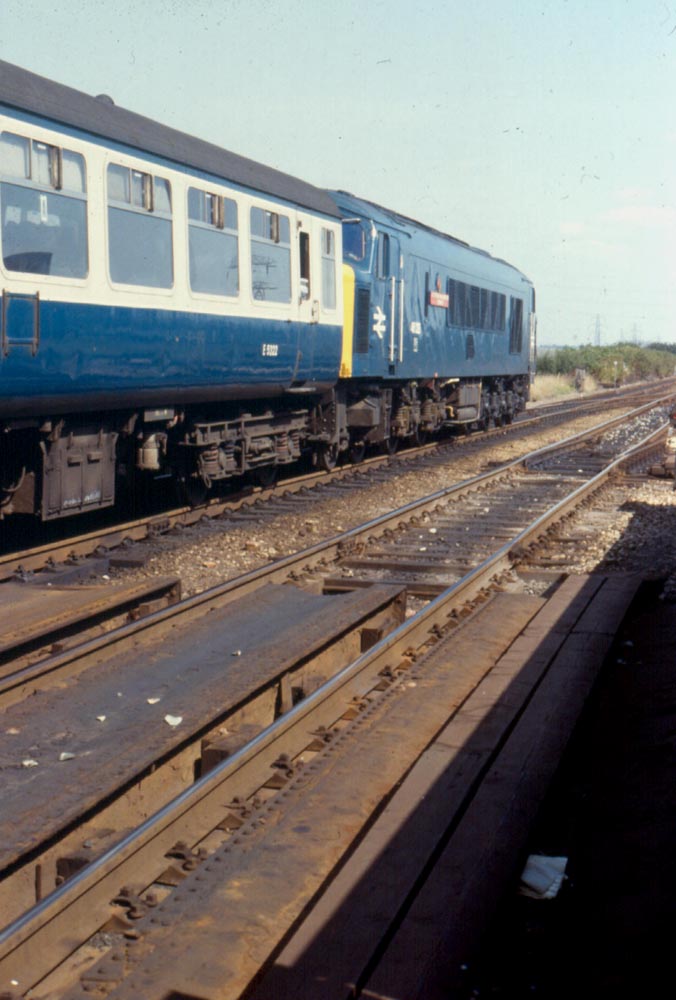
Mal believes the above train is the Haydock tanks returning to Stanlow, having just passed through St Helens Junction Station, the footbridge is just visible in the distance, the sidings on left is the lead towards Bold colliery. The driver is starting to open up power since the last tanks have come off the curve and are now on the main line. The other two trains it could have been were the Ravenhead tanks or the Cowley Hill tanks, however they nearly always used a Type 4 locomotive. The Cowley Hill trains used the old line, a ground frame was installed to take you off the main line. From that point was the big climb on to Garswood.
In general the DMU units we worked were Chester based, mainly Metro Cammells, Park Royals, some Derby Lightweights and now and again Western allocated units. During the summer of 1978 I was working Chester to Rock Ferry, all stops. We had a Liverpool Division DMU footplate Inspector who lived in Chester and on this occasion was riding with me. We set off from Chester around 07.45 with a busy peak hour train, down to Hooton, then Bromborough where we pick up a big crowd. Between Bromborough and Spital workmen are busy trimming the trees. On approaching Spital I noticed the air pressure was dropping, after coming to a stand at the next station the air pressure was too low to proceed, as you know people sitting behind you, makes you feel uncomfortable. So we both get out of the cab and start listening for an air leak, which we can't immediately locate. I'm about to contact control when the Inspector finds a cock open on one side open, it should have been in the closed position, this is reset and the air pressure comes back. Apparently a piece of a branch was sticking up, and caught the cock. There was no noise from the leak, fortunately the Inspector was with me and he knew every valve and cock on these units. But he did say he thought there should be a noise of escaping air, I was just thankful him being there.
We did have a diesel multiple unit job where we finished up at Manchester Victoria, and then home passenger. I used to ride back on the Newcastle. The Manchester secondman was supposed to go forward to Liverpool Lime Street in order to work the boiler. I would let him go and work boiler myself, also to have a chat to Edge Hill man, and catch up on all the latest gossip. I never understood why the DMU's were all so different in the cab layouts, the isolation switches & key switches in different locations, never standard. I know they were made by different companies, but perhaps they could have told these companies to keep the cab layout the same. With the water problems, losing engines and the poor heaters I don't think they were a great success. Not to mention the brakes which were very poor. When I left Birkenhead I thought I would never have to drive one again, but was I wrong!
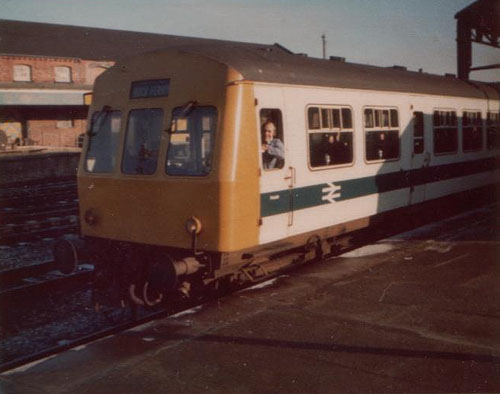
Towards the end of 1978 Mal records his last workings with the few remaining Class 24's. On November 28th 24063 was worked light diesel to Edge Hill fuel & inspection point and then returned light engine. About a week later on December 7th Mal's final working with a Class 24 was on the Shotwick trip doubleheaded with 25148. ( It is perhaps ironic that both these locomotives ended their days with collision damage - for 24063 it was whilst working the 14.20 Bidston Dock – Shotwick iron ore service that the locomotive collided, at Shotwick, with some wagons from the local trip working hauled by 25158. And 25148 ended its days sometime during June/July 1981 with extensive damage to one cab.)
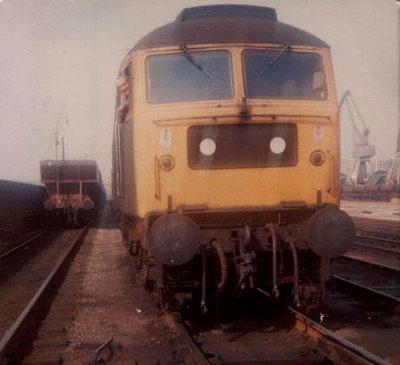
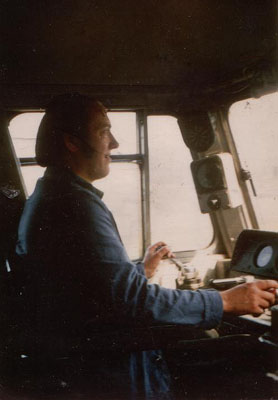
On the left is Mal in the secondman's seat of a Class 47 at Birkenhead Docks sometime during 1979 - see note below. On the right is Mal now at the driver's desk of the Class 47. The large box on the window pillar indicates this is one of the slow speed control equipped Class 47's. When arriving at the power station you were told what speed to set, anything up to 3 mph. You had to go into the engine room to set a switch which activated the slow speed control, you would then work to the power station signals.
During 1979 bulk coal carrying ships started arriving at Birkenhead Docks, the coal or slack came from Eastern Europe, Poland I think. The cargo was for Fiddlers Ferry power station, one place I thought I'd never would work a train to. The locomotives used were slow speed control equipped Class 47's. You were allowed one trip with the train to familiarize yourself with the slow speed control and the signals inside the station. My first job on this route was July 30th 1979, 47350 was used, 06.15 on duty 14.15 off. It was light diesel from Birkenhead to the docks then loaded to Fiddlers Ferry and return to the docks. This job ran right up to my leaving, some even went from Bidston Dock.
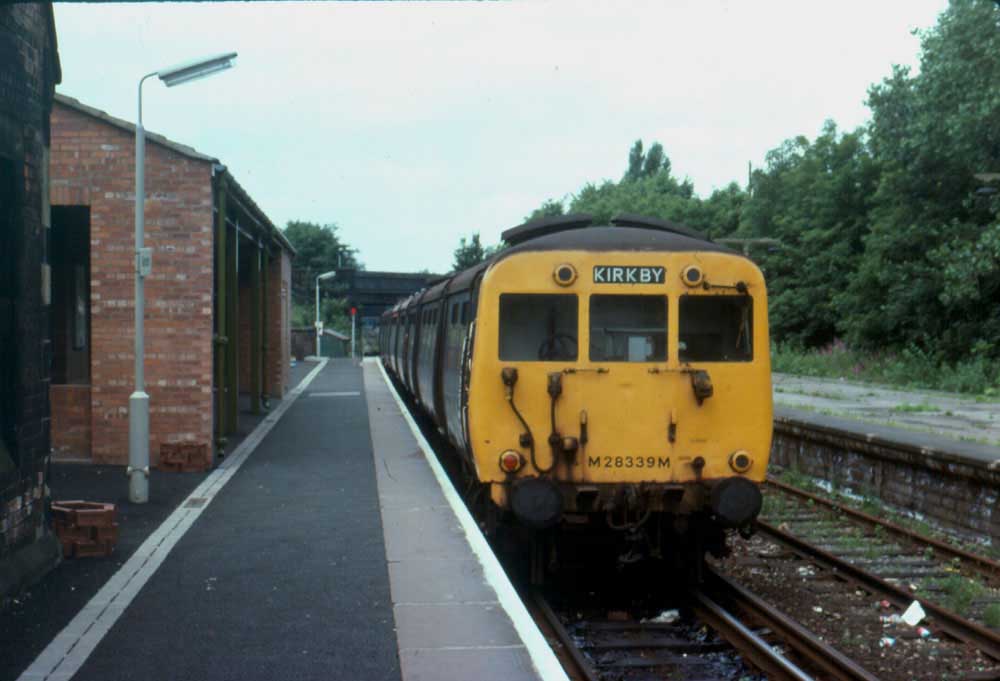
Change is in the air - Birkenhead to Liberia
The railways had always been an agent of change, whether to itself or its impact on the environment it operated in. During the previous ten years the change had been dramatic; steam had disappeared from the scene, major rationalisation of the diesel fleet was occurring, the WCML electrification was almost finished. Other changes were less obvious; the gradual disappearance of the short, loose coupled goods train, replaced by Freightliners and company trains made up of new shiny wagons and now all equipped with air brakes. In the Birkenhead area yards were closing, four wheeled wagons were vanishing quickly, the dock traffic was on the wane and oil pipelines now being built would affect the local traffic flows later.
I was now trained on the DMU's, not bad jobs but not quite my cup of tea, my last move would have been back to Edge Hill. But late in 1979, a young driver showed me an advert in the Daily Mail asking for experienced drivers to go to West Africa, to work for LAMCO in Liberia. The young driver had applied but was told he was not suitable due to having no experience on heavy trains, which could operate with up to 10,000 ton trailing loads.
Undeterred myself and another driver at Birkenhead applied and we both received interviews. These were held in Leeds, we both went together. He was senior to me. I passed the interview but the more senior driver failed. He had a slight stutter, since most communication on the LAMCO Railway was done over radio the stutter could cause problems.
As 1980 arrived, myself and the family (wife and three kids, one girl and two boys) head up to London to Guys hospital for complete medical checkups. These were passed, all with flying colours, later the wife and I had to go back to London for seminars. I was given a two year contract, to go out with the family. I would go first and they would follow two months later. I had given it plenty of thought, knowing I could not get my job back if it did not work out, but I had made my mind up I was going. At this point in my life I had never even been on an aircraft!
All the paperwork and official things had fallen into place, the passport had been sorted out, it had to be sent to Sweden to obtain a visa, the formal job contract and the tickets were received. I took them to the depot show the lads, most were happy for me. So I handed in my notice with the proper time given.
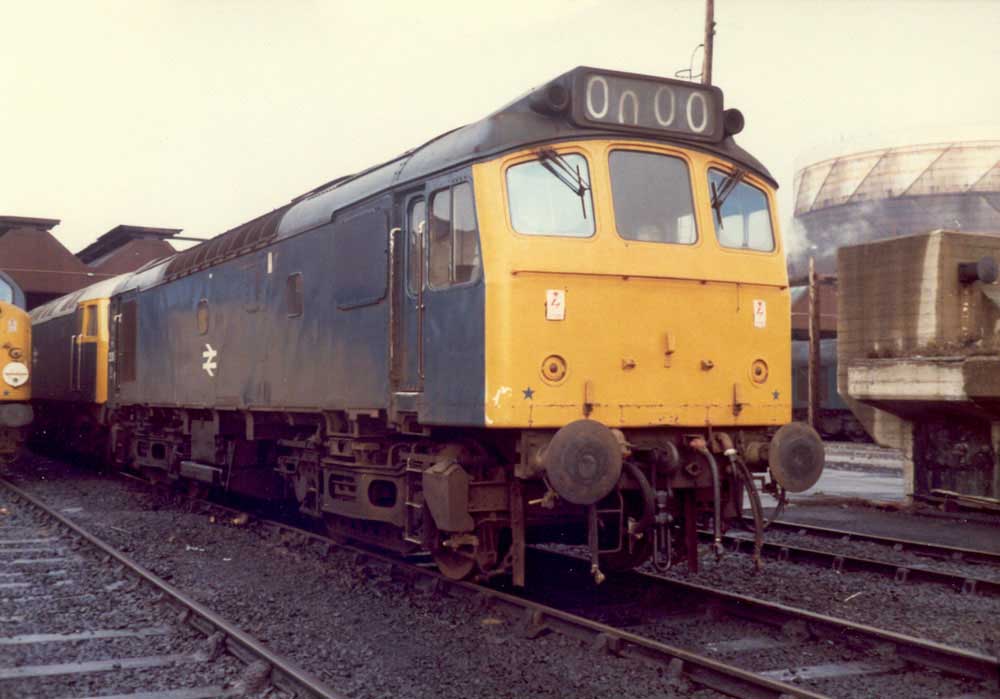
It's right at the end of my time at Birkenhead, February 28th Feb 1980, booked on 07.54, EMU turn. Around midday we left New Brighton for Liverpool, since the loop opened you would work northbound to Liverpool, round the loop and go back to West Kirby, you just had to remember to change the lights and destination indicator. When approaching Birkenhead Park with a three car set, slowly coming down the platform, a woman who had been sitting on bench, suddenly got up and ran to the platform edge before jumping in front of me. I let the controller go which activates the Driver's Safety Device. The units were fitted with Westinghouse brakes for emergency, there's a hiss of air and the train came to a quick standstill just short of the woman. I informed the guard and jumped down on to the track, pulled her up and walked her to the platform. She was in her own little world, the station foreman took over and reported the incident to control. And off we went but at the next station I was relieved, in order to give a statement to the police. That was just two weeks before leaving the job and thank goodness for those Westinghouse brakes.
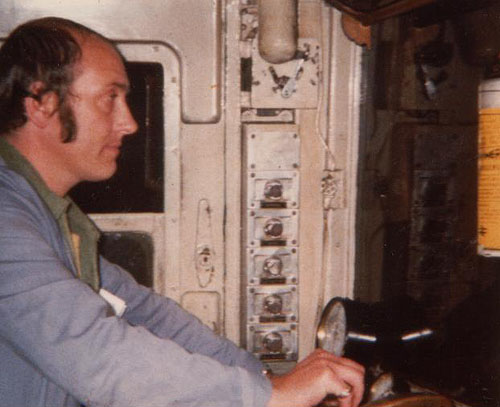
Before leaving Birkenhead, driver training had just started on the Class 507's. When the new loop opened, which is a single track round the city and returning at James St, there is a link from the up platform at James St through the old tunnel, joining with the new part of the northern line as it approaches Liverpool Central. This is used for interchanging stock between Kirkdale Depot and Birkenhead North.
My last diesel worked on British Rail was on March 6th 1980, 25106. The final job worked was an EMU on March 15th 1980, with my last official day being March 22nd 1980.
The next eight years were spent working on the LAMCO iron ore rairoad in Liberia - see link below to access this page. Mal's time at LAMCO ended when production at the mine was scaled back and fewer trains were therefore needed to ship the iron ore to the port. This may have proved to be a fortuitous set of circumstances for many of the now redundant mine/railroad employees to leave Liberia for pastures new because within a short period of time civil war engulfed the country, shutting down all iron ore production. Some of the very last employees to leave the mines did so literally in the nick of time.
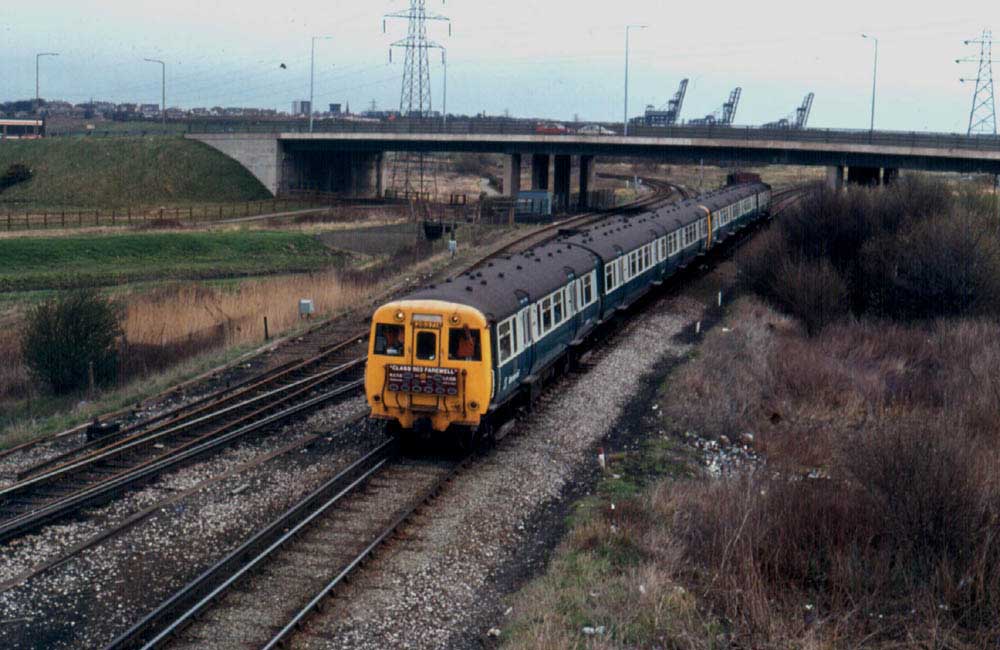
When working the loose coupled iron ore trains, either steam or diesel powered, when leaving Bidston Dock bound for Shotwick we always hoped to get a good run through the junctions and clear the curves, the last one being at the end of Bidston Station. The first obstacle could be getting the road over the New Brighton line, then onto the curves round to Bidston, which can be seen clearly in the photograph. Frequently we'd wait on the curve for a West Kirby train to clear.
![]()
Birkenhead Interlude
The presence of the docks in the Birkenhead area had required the use of small shunters, both steam & diesel for many years. In the final years of operations at the docks the small shunters in use were the venerable Class 03's. The deathknell for the use of these shunters was the considerable reductions in freight traffic, the increasing use of block train workings and the wagon load Speedlink services where the train locomotive generally took care of any shunting required for the train. Whilst Mal was having his adventures in Liberia, Birkenhead was very much in decline and some of the workings in the late 1980's were noted down and captured on film by Ron Kosys, without whom this small section would not be possible.
A trip to Birkenhead was made on September 25th 1987 to coincide with the late afternoon departure of the Speedlink to Whitemoor. Generally the Class 03's completed most of their work in the mornings. The 'active' locomotive was always stabled on the Liverpool side the level crossing at the east end of Cavendish Sidings.
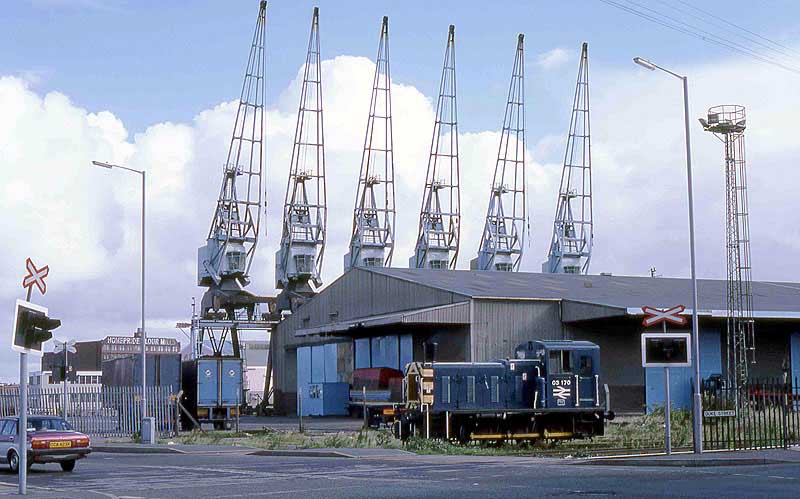
On February 13th 1989 the weekly working from Toton to Birkenhead North CCD would coincide with the working of the tripper from Warrington, providing two photographic opportunities, although the Toton working did not normally require the services of the Class 03. The journey was made to Birkenhead only to be greeted by very poor weather and the bad news that the Warrington job had been cancelled. Attempts to salvage the day led to much pleading with the Class 03 crew who eventually came good and agreed to work the Toton train to and from the CCD rather than see us have a totally wasted trip. This resulted in giving the coal train's Class 37 driver an unexpected layover at Cavendish Sidings.
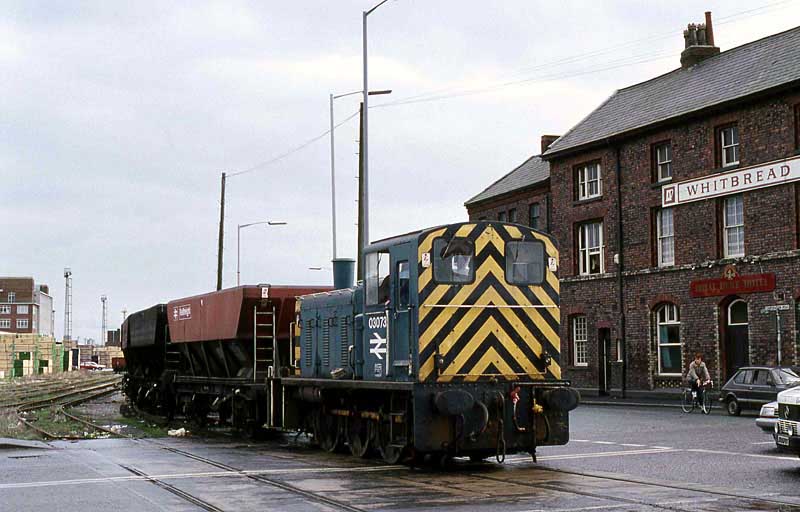
It was less than month later, on March 8th 1989 when the Class 03s handled their last job at Birkenhead. The Speedlink trip was booked to run, the weather forecast was iffy to say the least, so off we went to see what would take place. At Birkenhead another couple of enthusiasts had also decided to cover the last day and had made a final day headboard. Again there was bad news, overnight the locomotive had been vandalised with at least the offside windows being totally smashed. This effectively meant that the shunter wasn't going to do anything other than run back to the depot for the very last time. Further, the inbound train only had a couple of Cargowaggon twin-sets which only required a simple shunt, and this was normally performed by the trip locomotive anyway. But once again the Birkenhead crew made good and responded positively to requests that the Class 03 make its final shunt in front of the cameras. After the shunt, 03073 ran along the Mersey Docks & Harbour Board tracks for the final time, regaining BR property on the west side of the gated level-crossing.
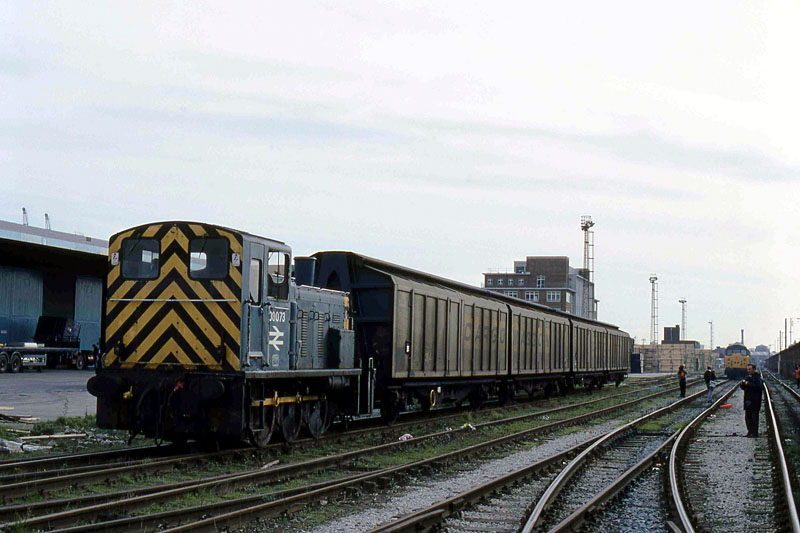
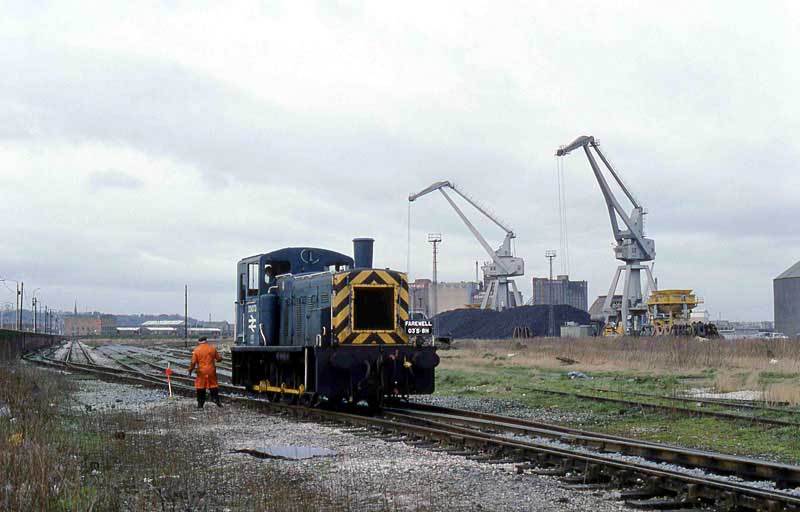
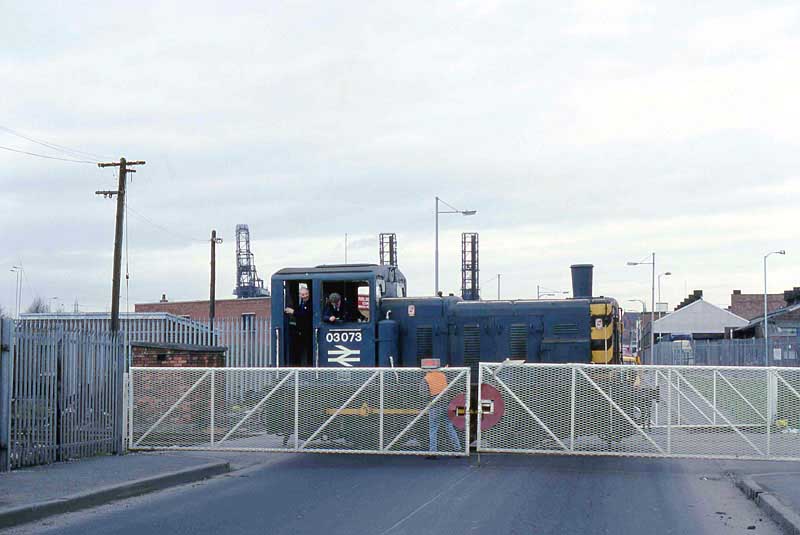
![]()
Whilst Mal was in Liberia Birkenhead Mollington Street depot would close with effect from November 25th 1985. Refuelling would now take place at Chester and locomotives would be stabled at Ellesmere Port East End Yard. On November 23rd Mollington Street held 25057, 25268, 25278 & 47247.
![]()
Back to British Rail - 1989
The story now picks up from the 'Liberia' page where, after an extended return trip back to the UK, and a time of settling back into the routines of life on Merseyside, it was time to get a job! But easier said than done - as well as the difficult challenges of finding employment on Merseyside, my age was against me. But Christmas 1988 passed and the New Year brought 1989 on to the calendar and still no job. But there was a bright spot, I'd kept in touch with the ex-LAMCO employees, including talking to an ex-dispatcher Frank Swindles, who was now working for British Rail in the Bletchley area. He asked me was I interested in a railman's job at Watford, where they were recruiting.
I said yes, took care of the basic formalities and received a letter for an interview at Melton House, Watford. The trip was made down to Watford, successfully handling the test & interview. Next week a letter arrived offering me a position as a railman, and a start date of March 13th for training. This started at Hatch End station on March 28th 1989. After six weeks training I was assigned to Bushey station. I was still in touch with Mick Boyd, who at the time was at Watford. He arranged some lodgings for me with someone he knew and during May 1989 Bushey station became my new place of work. The lodgings were ideal. During my first week on station duty Frank told me a guards school was starting very soon and would I like my name put forward. This was done so I went into the trainman's school at Euston. All the testing went well but at the time you had to be below 45 years old to go on to be a driver. Frank explained my experience to the powers that be at Euston Headquarters, but management and the unions had made their decisions and there was nothing they could do.
Not withstanding this I was quite happy having a job! The course was a long one, up and down to Euston each day, retracing some of my locations around Euston, the Hampden Club had long gone. After the school, I was sent road learning including Watford to Euston, the North London line to North Woolwich and Richmond, also into Liverpool Street with the Class 313's where the driver would put the pantograph up, and lift up the third rail shoes, these units were similar to the 507's on Merseyrail. I remember seeing some of the old electric loco's I had worked on at Lime Street now working out of Liverpool Street!
The end of road learning at Watford was near, the training included the short route to Croxley Green, which was to close soon after, also the route to St Albans Abbey on the single line under the overhead wires, I had been stretching it out. On a few occasions I had arranged to meet Frank Swindles at Bletchley, his job entailed going around the signal boxes in that area checking how the men were working in the boxes. I went with him to some boxes on the Bedford line, brought back more memories. The biggest shock was Milton Keynes, my last stay at Bletchley had been in 1964, a beautiful rural town, now a London 'new town' bedroom community, nice and modern but no character. It was my last week road learning and I would be signing the routes on the Monday. The stay in my lodgings was for three months only and that would be coming to an end shortly. I had asked for a move north but was told there was no chance.
It was Thursday I was going home to Ainsdale, where we now lived, for a long weekend. Out of the blue whilst at Lime Street station I bumped into ex-Birkenhead driver Billy Warburton, who was a hell of a nice guy. He asked me what I was doing now, he knew I had finished in Liberia; I brought him up to date and mentioned Watford, he said to me 'Leave it with me, I will see what I can do'. I gave him my phone number and off I went. The next day Friday the phone rang, it was Billy, he asked me if I had to go back down to Watford for anything, I said yes - work! He said have you left any thing in your lodgings, I said no, I bring the few things I have home each time. He then shocked me and said Mally your finished at Watford, on condition that you have to be demoted!
I said whatever you say. Imagine how I felt, like a ton weight lifted from my shoulders. He said you start work in Aughton Road crossing box on Monday. Aughton Road is in Birkdale, just two miles from where I lived. He said go to the crossing box, someone will meet you there to sign some papers. I said what about Watford, he said forget it. Billy knew by my voice he was doing me a great favour, I did thank him, but I had known him since 1966, back then I'd fired for him, he was always cheerful, plus very clever. He had the deputy TCI job at Birkenhead when I was there, so I was not surprised about him being promoted. I contacted my lodgings and told them what had happened and sent them a cheque for the amount owed, thanking them for their understanding in my sudden departure.
Its Tuesday August 29th 1989 and I'm off to Rail House, Liverpool Lime Street for a 09.00 appointment. I'm met by one of the signal inspectors, a few questions are asked, documents are signed and then we're off to Aughton Rd. I'd been in dozens of signal boxes in my time and this was no different, you had a small frame and worked under instruction from Birkdale station signalbox. The gate mechanism was the old type all manual, with a big wheel to open and close the gates, when closed a locking lever kept them in place, a really old piece of machinery! I was told to work under the supervision of the other person in the box, the Inspector would call back the next week and follow up on my progress. The other signalman was from London, in fact he had worked at Euston station as a water filler, filling the coaches with water etc, so we had something to talk about.
The job worked out well and I quickly fell into its routines. The Inspector returned on September 6th, another form was signed, he asked a few safety orientated questions and that was that. From the following Monday, September 11th, I started alone in the box on the shift which ran from 14.55 to 23.50. I could sit back and reflect over the last few months; Frank Swindles, Mick Boyd and Billy Warburton, nothing could have happened without help from them. The second week in the box working the first shift - 05.55 to 14.55, these were easy shifts to work, every other Sunday to work, and rest days optional. From Birkdale signal box which was close to the station, towards Southport which was next station you had the three crossing boxes; Aughton Road, Duke Street and Portland Street, all in a straight line and within sight of each other, the passenger service was every fifteen minutes which you kept busy, sometimes you got the two trains passing together, which made it easier. You had to be careful when closing the gates, you needed good timing.
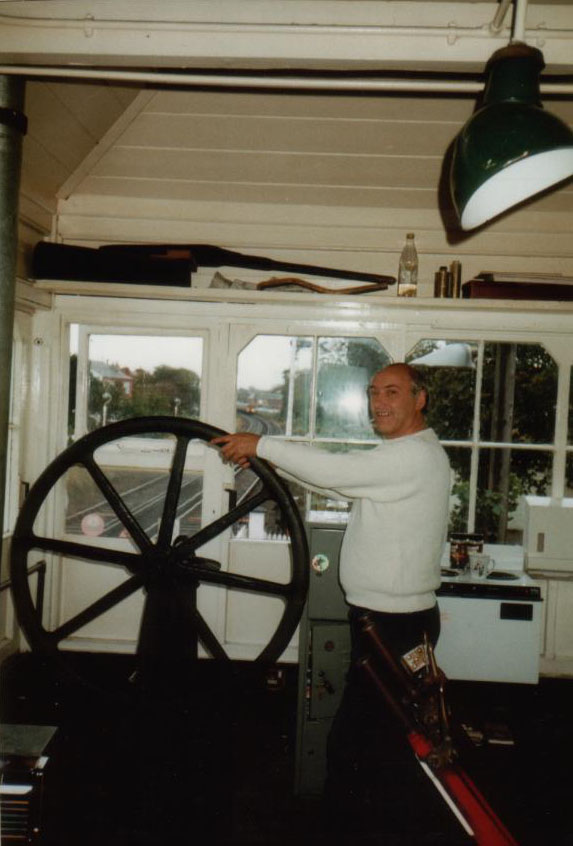
On the early shift there was opportunity to nip over to the newsagents and pick up the Mirror and the Mail and then cook my breakfast. The phone was my connection to the other signalmen, including getting to know them, one showed me how to call outside numbers, which was most useful! The local bobby doing his beat would call in daily for a cup of tea and a good chat. Across the road was Ginger McCaines car showroom, behind this were stables, the horses used to trot over the crossing every morning and head down to the beach for their exercises. I knew nothing about horses, maybe Red Rum was one of those I'd seen, the only bet I ever had was on the Grand National!
During October two of the drivers from the Southport train crew signing on point visited the box, both had been at Birkenhead during my time there. One was Peter Hughes, who had unsuccessfully applied for the job with LAMCO, he wanted to hear how it had all worked out, of course there was plenty to tell him. The other driver was Arthur Pollard, ex-Springs Branch and Birkenhead who was a keen railwayman, very knowledgeable on railway history, always good to have a chat with, he had passed on steam after me working the 09.43 Glasgow out of Liverpool Exchange. He recently retired from Southport, and would be one of the last men passed on steam in the country. With the year end rapidly approaching the decade of the 1980's was about to close, it had started with my last days at Birkenhead, then an adventure in Liberia, then back to Merseyside, still on the railway!
Having settled nicely into the routine it was around April that a vacancy for the relief man came up, I had my car so covering the four boxes would be no problem. I asked about the position and the next thing I know is I am the relief man! Somewhere about this time all the boxes were having the old gates replaced with modern barriers with skirts fitted. These were much easier to work with their warning road lights and warning sounds - they required a control desk to be fitted, so out went the familiar wheel. The extra boxes to cover were Duke Street, Portland Street, as previously mentioned and Brookhall Road, which was towards Liverpool, in the Crosby area. On the relief job you were allowed travelling expenses.
All the boxes had their own unique characteristics - Brookhall Road was full of plants and flowers, Portland Street seemed an older type box, the two regular guys working this box were from the old school, regularly mopping the floor during their shift, cleaning the windows and using the brasso to shine the instuments and levers, the other young relief guy was frightened to go in their box! I had a few rows with one of the guys in the Portland Street box, I was not an untidy person, but when you were covering his box as he called it, he would call in on his day off to check things out, the first time he did this was halfway through my shift. He came in and started moaning about the floor, I could not believe this but mopped the floor before my shift was finished. This time he picked on the wrong guy, I told him to leave, he said he could stay in his box as long as he liked, I picked the phone up and called the signal inspector and told him this person was trespassing in the box when off duty, give him the phone, I can imagine what he was told. He left immediately with a moody face. I had seen this kind of obsession in boxes before all over the system. Some times you would go to sign the register in the box, the signalman kept the door locked and would bring the book to the door to let you sign. Others would place newspapers all over the floor, once you had signed the book they showed you the way out. Not all were like that, some would want to chat with you, and were very friendly. Takes all kinds I guess!
Now well into the New Year it was time to think about holiday plans, enquiries to my wife suggested a trip to visit her sister - in New Zealand! With this in mind it seemed only natural to go around the world, something that would take six weeks if it were to be worthwhile. It started off with a call to the roster clerk telling him I needed six weeks using time accumulated from 1990 & 1991 and the rest owed odd days with three days loss of pay. Once the roster clerk knew about the round the world adventure things fell into place and the detailed planning started. I'd heard the story many times of train crew saying they would make these long distance trips to see family and friends when they retired, but too frequently when retirement came they were no longer able to make the journey due to frailty, illness or other reasons not forseen earlier. Because of the length of the holiday a special form had to be filled in and signed concerning leaving the country for more than a month.
In the meantime Arthur Pollard had called in the box to see me, letting me know they were starting a trainman's course soon, and he had brought the application form down to the box. I filled the form in, gave it to Arthur who submitted it on my behalf. The application was successful, my letter of notification arrived at the signal box. Trainmans school is at Lime Street, my last turn in the signalbox was at Aughton Road on August 11th 1990. The school started two days later at 07.35am. There were about a dozen of us in the class from Southport, Birkenhead & Kirkdale. Mike, the instructor was an ex-guard from Blackpool, he was a very easy going person so the school was a happy one. He knew my background, so I could help others in class.
One thing which reminded me of the school at Euston was the task of coupling stock to a locomotive, which we'd done at Willesden. Our class included a lady, when it come to hooking on to a coach, which was part of the training, she could not lift the shackle up, she then said I'm getting grease in my hair. Not long after this, this part of the course was dropped. At Lime Street they had a mock up of the vacuum and air pipes, the trainees were all struggling with connecting the pipes. Mike asked me to show them how it's done, I was in and out so quick, pipes attached. Mike said slow down let them see what your doing! I enjoyed the course and made some friends, all younger than me, I helped them all I could.
Once the school time was done the next job was road learning. This took place over the electric lines including Ormskirk, Southport, Kirkby and Hunts Cross, plus unit training on the Class 507's and 508's, the road learning finished on Friday October 19th. As well as getting reaquainted with some drivers from the past I was also getting to know the sons of drivers and guards from the past. I started work on the EMU's on November 1st 1990. One item of note was the growing influence of the health and safety issues, the rule book was changing as we progressed. As mentioned elsewhere I was not keen working on the units, even driving them. But at least on these jobs you could chat with the public, or rail employees travelling in your cab at rear.
But with the end of the year closing in it was time for our world trip. We were set to leave the UK on Monday November 12th, our travel arrangements handled by Austravel and Britannia Air. The first leg was on a United Airlines DC10 to Houston, renting a car to spend four days at Galveston. Then on to Los Angeles on a United Airlines MD or DC9 not sure? Change here for a United Airlines B747 to Hawaii spending four days in Honolulu. Still with United Airlines we then had a B747 to Auckland, New Zealand. The last leg of this flight still remains our roughest trip, electrical storms over the Pacific were causing major turbulence. The guy sitting next to me was a light aircraft pilot and visited the toilet just prior to running into some of this major turbulence. We were buckled in tight but the guy in the toilet was tossed about like a rag doll, it was quite a while before he returned to his seat. Quite an experience but we all landed safely in Auckland, the wife was excited ready to meet her sister.
Our stay in New Zealand was a happy one, nice party to welcome us, we were given the use of a car for the duration of our stay. We toured most of the North Island, there's plenty of room, beautiful scenery similar to the Lake District or the Scottish Highlands. We depart on December 17th using a brand new B767 Britannia Air for Singapore with a fuel stop in Melbourne. From Singapore after a stopover we're off on another B767 Britannia Air to Karachi, should have been Dubai but the Gulf War had caused changes. At Karachi airport we have to remain on the plane, during the stop the military surround the plane, very uncomfortable. We're back at Luton on December 21st, pick up our car from Mick Boyd's house and drive home. Its back to work on Christmas Eve, then off on Christmas Day and Boxing Day, finishing the year off working a late turn, the last train from Central to Southport.
We soon settled in again on the EMU jobs, not bad turns, no nights and very few late turns. Working to Hunts Cross, a few peak hour jobs to Kirkby and Ormskirk, on the whole its quite enjoyable. The Hidden report came out in the summer, one result is the stopping of staff from working excessive hours. Now every eight weeks we go to Kirkdale for a safety day, an update on safety regulations. This took place all over the system. There are rumours about privatisation, there are plenty of inexperienced drivers coming onto the rosters. One common problem is that of the trains picking their wheels up, as a result of the increasing use of disc brakes, which includes all the trains on Mersey Rail. Long gone are the old fashioned brake blocks which cleaned the wheels, so as well as de-icing trains for the third rail they have to put a substance on the running rails to give better adhesion.
Line capacity is being reduced, familiar loops and sidings are being removed, so there are fewer places to put failed trains. An example of delays, working to Liverpool the driver is stopped by a lamp filler man, who tells him the location of a broken rail ahead. We draw forward to the break and stop, I walk through to see, he asks what would you do, I say five mph over the break and carry on after reporting the problem at the next station. Instead we stand for two hours until a permenant way man arrives and says five mph over break and carry on, what to do! At this point time the differentials in pay were not so great, the next thing to worry about were signals passed at danger (SPADS), they were on the increase, no doubt caused by a lack of experience coupled with the brake systems on the trains. Everything is slowly changing, no more goods guards, no more secondmen, locomotives are dwindling. The company trains have taken over from the old four wheeled vehicles, talk about privatisation, I see my first Class 142 multiple unit - it's just a bus on rails, the old DMU'S are almost finished.
So in October 1991 I put in for a conductor vacancy, at this time Southport have about twelve conductors, working units to Rochdale via Oldham, the locomotive hauled Manchester Victoria club train with six or seven coaches. The morning train out and the return train during the late peak hour. Also to Wigan, Oxford Road, Stockport and Hazel Grove, the drivers work electric and diesel units. We at that time could cover electrics for overtime and emergency reasons. So on January 13th 1992 I start the conductor course at Preston. After seven weeks in the school you go out with a minder, checking and issuing tickets, then a few weeks road learning. The jobs from Southport are easy going, work out to Manchester, hang about, and work back to Southport. I finally take over April 13th 1992. Now aged almost fifty, this as I thought will do me, I wanted to finish at sixty, no one could foresee the big changes just over the horizon.
It doesn't take long to settle into the routine of the conductor's jobs at Southport, they provide good booking on and off times, easy jobs. The locomotive hauled job was a semi-fast express, very busy morning peak to Manchester Victoria. Here the coaches go empty stock up to Newton Heath Depot, when working this job over the Atherton line the four roads had now been reduced to two, I realised we were going over the same route as I worked in 1965/66, with a class 40. Same kind of train but now with an old Class 37. On the afternoon job you would bring the empty stock down to Victoria and return to Southport.
The rest of the work was with Class 142's, 150's and 156's very mundane.
On July 12th 1993 whilst working out of Southport with a 156 unit, the train was in collision with a fruit and vegetable truck at a crossing, nobody was injured but a window was cracked in the drivers cab and some damage was sustained by the coupler. The passengers were detrained at Burscough and the unit went forward to Wigan Wallgate sidings. On the short stretch of line from Meols Cop to Parbold there were a considerable number of crossings including those at Pool Hey, Wyke, Bescar Lane station, Drummersdale, Boundry Farm, Betts, New Lane station, Watkins, Crabtree, Shaws, Four Lane Ends, Arnolds, Frog Lane, Dean Lane, Ferrett, Parbold station and signal box and Chapel Lane, all in less than ten miles! This was rich agricultural land, excellent for growing crops, hence the reason for many of the crossings.
As the year ends still working EMU's and going to Kirkdale for the safety days, now coming up to end of 1993, it was during this time that I encountered a complete train failure. A Class 150's engine seized up at Parbold on our train, unable to be moved as there was no skate in the area. The train was off overhaul at Newton Heath, there was no oil in the sump! The route to Rochdale via Oldham was some of the worst railway I ever worked over, talk about all the twists and turns. 1994 gets underway, our holiday is to India in January. On return we will not be covering EMU turns anymore, last EMU worked late in January 1994. During March we have our last safety day at Kirkdale, in future we will be going to Manchester Victoria for safety briefings. During the summer of 1994 the signalmen had a series of one day strikes. The new IECC Power box opens at Sandhills which will control most of Merseyrail's lines. The familiar crossing boxes are now consigned to history, along with many other signalboxes. Another indication of the times is the practice of substituting buses on routes which are blocked because of engineering work or other reasons. This is not helped by the loss of many diversionary routes over the years and less single line working. Its off to Turkey in September for our holiday, upon our return more information becomes available about privatisation.
Starting in the New Year 1995 we the conductors had to go in pairs to the personal people in Manchester, we were told Southport would no longer have conductor guards but we could transfer to any of the North West Depots, more or less we were redundant. Some of the conductors wanted to be put back to trainmen, but this was not allowed as it was a different grade, the trainmen were now working for Merseyrail, we were North Western Trains, confusion! The Southport drivers were no longer allowed to work diesels, that work went to Wigan. I found most men were not informed enough about privatisation, what the outcome would be when work was split between the companies. Two conductors went to booking offices the rest were split up, one to Blackpool, one to Wigan, and the remainder, including myself, to Liverpool Lime St, although this time with travelling expenses. The last job worked at Southport was on Saturday January 14th. We were told to book on at Wigan the following week, until arrangements could be made for us to sign on at Lime Street.
The week at Wigan Wallgate was more or less a waste of time, on the following Monday, January 23rd we all went to the personal offices at Liverpool Lime Street, booking on at 09.00am. The week went very quickly, filling forms for equipment, checking existing equipment, signing routes we knew etc, straight away I am bumping into drivers I had worked with at Birkenhead and Edge Hill, including secondmen & guards who were now drivers. When Birkenhead Mollington Street had closed during 1985 the men were given an option to stay at Birkenhead Central or move to Ellesmere Port, which was a signing on point for tank trains. Some came to Lime Street. We finished the week off stock training on 158's, walking routes etc. The men at Lime Street had been given their option to go over to Virgin for the London work, or stay on North Western trains. At this time the North Western trains had good work including Leeds, York & Nottingham, but it was not realised at the time that this work would eventually disappear.
We started route learning the second week; Manchester Airport, Morecambe & Heysham, Blackpool, Chester/Ellesmere Port, later to Leeds, York, Nottingham, Wakefield with locals to Wigan, Warrington, Preston and Stalybridge. There were a few locomotive hauled jobs to Preston, in all quite a variety of work. During April I began working these trains. During June 1995 it was time for our next holiday, three weeks in Thailand, very enjoyable! Back to work it was learning the road to Nottingham via Sheffield, really enjoyed this first time over routes I had heard so much about by my Toton friends. The route was Warrington Central, Manchester Piccadilly, Stockport, Hazel Grove, onto the Midland line through Chinley, Dore and Totley, Sheffield. Change ends here, then off to Chesterfield, Alfreton and via the Erewash line to Nottingham, good jobs about seven hours out and back. This was also my first time working beyond Neville Hill to York. The Wakefield job we would change ends at Wakefield Kirkgate, then run up to Wakefield Westgate and terminate.
For the trips to Morecambe we would work to Morecambe then do a few trips between Morecambe and Lancaster, and an odd trip to Heysham to meet the ferry boat. Morecambe had completely changed, there was barely anything left. Only a two road island platform with a small booking office and waiting room, a ground frame and single line down to Heysham. During the summer of 1995, suddenly the Leeds and York work was transferred to the Arriva train company. We were to keep the Wakefield jobs, which were stopping trains. Then the locomotive hauled trains to Preston ceased, drivers would now no longer work on locomotives. Speaking to some of the older Virgin drivers after their reconstruction, they wanted out. Some North Western drivers were applying to go over to Virgin Trains.
One incident on an August Sunday Nottingham turn, we were diverted via Derby from Clay Cross, I had a conductor over the road, at a place called Stretton the train hit a swinging brick, which smashed the cab window showering glass over the driver Dennis, who was a good mate of mine from the early seventies. He called me to come forward, I immediately got down on the phone to the signalman and told him to warn drivers on the opposite track of the situation, the brick was still swinging over both lines, I then told him to give us a clear road into Derby, for we had an obscured view with the window shattered. Back on board, Dennis had powdered glass all over his face, we managed to get the train into Derby Station, where I had a big row with the station inspector. First time in Derby, not knowing this was an Inter-City station. He had no interest in regional trains. When our train stopped in the platform, I took Dennis straight to the porters room to wash his eyes, this guy comes in, doesn't ask how Dennis is, he just wants to get our train out of station as soon as possible. I told him what I thought of him, he was no help at all. Dennis would not go to hospital for a checkup, they put a Class 150 on the front of the 158, he took us on to Nottingham. Another Lime Street driver who was supposed to go home passenger worked the train back. Despite this incident the Nottingham men were very friendly to the scousers.
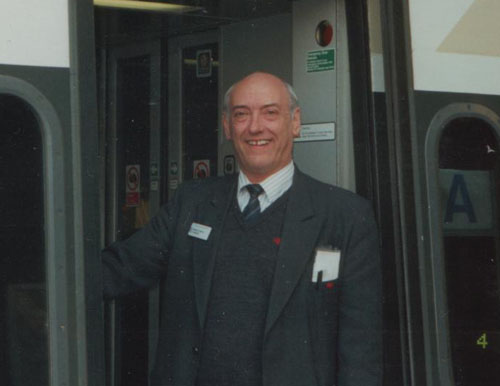
Into 1996 there are more changes, our company was to become First North Western and were to be restructured, up to this point working at Lime Street was all right. During March 1996 its off to Eurodisney for a week with the grandkids, travelling on the the new Eurostar service. My last trip to Nottigham was on May 20th, from June Central trains took over the workings, more men would want to go over to Virgin, the depot is now a unit-only depot.
Early October we had a holiday in Tunisia, found it boring so booked excursions all over the country, the trip to the Sahara was very good. At year's end the older personel are not so happy.
We move into 1997, we have now been restructured, one shift could be six hours the next ten. I think I was too set in my old ways to embrace the the new changes, the basic pay was much better, but some of the jobs were monotonous. More drivers were leaving, going over to freight working at Crewe. Can't say I blame them, all those years of experience and ending up on these jobs. During September we were off to Sri Lanka for three weeks, first time on a Boeing 777, beautiful place. For medicals we now go to a private company practice in Manchester.
Into 1998 its the same same thing, I suppose the most enjoyable jobs were the Morecambe and Heysham diagrams, at least you work out and back once. The other jobs were repetitive - three trips to Wigan and back, or Blackpool and back then Chester and back. We take a holiday to Malta, then back to work, thinking at that time, I couldn't do this work until I was sixty five. Before you can blink 1999 is here, despite having done the job for a while I'm still not adjusted to it. We get a new diagram, work to Wigan North Western, run into the bay, change ends and work all stops to Bolton, over the same route first worked forty years before, then on to Manchester Victoria. By this time my son Gerard, who is now working for First North Western, goes on his first driving turn on Saturday March 27th March. We go on a Mediterranean Cruise in June with my wife, sister and dad. Our cruise ship is the ex-Empress of Britain, CPR Lines, ironically my dad's first ship was with the same company. Back on the railway we have a whole new set of train crews, many had started under the new regime, so this was the norm for them.
In 2002 the opportunity to take retirement occurred, which Mal took, ending a very varied railway career which had covered all types of traction.
![]()
The links below will take you back to Mal's steam years - 1960 to 1968 or to his time spent working the LAMCO Railway in Liberia:
Part One - The Steam Years 1960 - 1968
Part Three - Memories from Liberia 1980 - 1988
Acknowledgments and thanks:
Obviously to Mal for putting together an immense amount of memories and data in email form to allow this webpage to be created.
Also to David Rapson and Tom Sutch for the generous use of their photographs.
Page added December 6th 2008.
Last updated June 19th 2011.